Do you like this information? Share it!
1. Introduction
The purpose of this web site is to help you make useful products at home that contain fragrance oils, essential oils or aromatic herbs. When I was a child I remember collecting wild violet petals and putting them in water in an empty vitamin bottle in an attempt to make violet perfume. I got discouraged when the concoction quickly turned brown and icky. Now that I'm an adult and have access to more knowledge and proper materials, I can still recapture that sense of fun and experimentation and often make things that are a pleasure to use.
Why Make Things That Are Readily Available for Purchase in Stores?
You can buy the kind of products I'm going to discuss on this web site, for example soap, bath salts, carpet freshener and countertop cleaner, so why make your own?
In my case, I enjoy growing herbs (legal ones only!) and learning about the historic uses of plant products as a hobby. I also appreciate the following benefits:
- Saving trips to the store
- Reducing the environmental impact associated with store-bought products of packaging, transport, and chemicals
- Making cleaning products that are safe to use around my pet bird
- In some cases, saving money
- Products can be made to my specifications and preferences
- Products are often superior in quality to store-bought versions
- Knowledge of what is in products and what the purpose is helps me make better choices as a consumer when I do want something store-bought
- Satisfying outlet for creative urges
- Making unique gifts
I want to stress that I am a hobbyist, not a scientist or a chemist or anything like that and I'm still learning better ways to do things all the time. I hope what I've learned so far will be useful to those who want to do their own experimenting.
Melt and Pour Soapmaking
I got my start in the extremely fun and addictive hobby of melt and pour soapmaking several years ago when I bought a melt and pour soap making kit for my Mom for Christmas. She asked me if I would make the soap in the kit for her. Well, she liked the results and I liked the process AND the results, and I've kept making melt and pour soap ever since. Some of you out there might enjoy some of my recipes if you are interested in trying this fun hobby yourself.
The basic process of melt and pour soapmaking is very simple. You purchase a pre-made melt and pour soap base from a craft supplier, melt it, add soap colorants and fragrances and other additives as you like and pour the liquid into molds. As soon as it's cool and solidified, you pop it out of the mold and it's ready to use. There are many ways to elaborate on this basic procedure.
The knowledge of melt and pour soapmaking and related crafts that I do have comes from the instructions that came with the various products I've used, a couple of books, (scroll to the bottom of this page to see a link to one of them), and various web sites and e-groups. Personal experimentation and trial and error has taught me a few things as well.
If you have never crafted with melt and pour soap before, please read the following information for a good overview of the process:
The suppliers mentioned on this web site all have acceptable quality products and service as far as I'm concerned, though obviously I've only tried a few products from each. Life of the Party Brand is sold at the Michael's stores in our area, so due to the easy availability I've used their products a lot. The other suppliers I have ordered from online. Of course unless you use the exact same supplies I did, your results will vary somewhat, like any craft. You'll develop your own preferences for materials and suppliers based on what factors are most important to you. I'm only a hobbyist in this area, not a scientist or a chemist, so I don't presume to know the best or only way to make the items.
Helpful Hint #1 - I print out any good instructions or recipes that I find online and keep them in a binder. I print on one side so I can take notes as I work on the blank side. I would never remember what I did with each batch otherwise, especially because I almost never leave a recipe alone or make the exact same thing twice, I love to modify the recipes and experiment. Any booklets or product packaging that contains good how-to information I add to the binder as well.
2. Supplies
Like most hobbies, you can go out of control with buying supplies if you're not careful. For beginners, I recommend getting a kit. It will most likely contain at least one mold, soap base, fragrance, and colorant. By using the kit, you can learn the process by following the instructions that come with the kit and familiarize yourself with what the ingredients look like and what they do. Also you can see if you enjoy it or not. Then if this is something you want to do more of, you can add on to the original kit based on what you're interested in making.
Besides the basic kit, it is helpful to have:
- Glass measuring cups, including at least one 2-cup size
- Large thin knife with non-serrated blade
- Eyedroppers
- Cutting board
- Spoons
- Plastic shoebox sized storage boxes
- Plastic wrap
- Spray Bottles
- Paper Towels
- Cleaned plastic food containers of assorted shapes and sizes
When you get a little more advanced, you might want to add these items to your kit:
- Strainer
- Melon baller or curl-cutting tool of choice
- Serrated cutter - mine came from Soap Wizards. They don't seem to have it any more on their web site. A friend of mine told me when she saw it that you can get similar ones from culinary tool suppliers.
- Soap cutting mitre box
- Metal cookie cutters, canape or pastry cutters
- Additional soap molds
- Dust Mask (for handling mineral powders, clays and any other particles it's best not to breathe)
To make the task of packaging homemade products a little easier, I have made a set of rubber word stamps for my rubber stamp line that I sell at Carolyn's Stamp Store: the set is called Products of the Kitchen and Garden Unmounted.
3. The Recipes and Ingredient Lists
NOTE: BEFORE MAKING ANY OF THE RECIPES PLEASE READ THE SAFETY INFORMATION INCLUDED IN THE Useful Essential Oils, Herbs and Botanical Products SECTION.
*EO - essential oil
*FO - fragrance oil
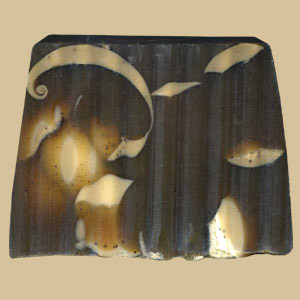 Spiced Coffee Soap Bar
Spiced Coffee Soap Bar
This soap bar is colored entirely by real coffee beans and the fragrance comes from the beans, vanilla powder and also from soap fragrances. If you enjoy the smell of coffee and spices you should like this one! The goat's milk powder will soften your skin too.
To make it first grind up coffee beans. I used decaffeinated beans because that is what I had on hand, but you can use beans with caffeine if it agrees with you. Melt some clear soap base and stir in the ground beans. Let cool.
Grind some more beans and stir into some melted opaque soap base. This will become the "cream" swirls in your coffee.
Remelt the opaque soap base which should now be a light tan color and strain out the coffee grounds. Pour about 2/3 of the tan soap into a separate container and add vanilla powder. Strain into another container if necessary to get out the lumps. Let harden.
Take the remaining 1/3 of tan soap and melt in about an equal quantity of white soap to make a lighter cream color. Add goat's milk powder and Allspice fragrance. If necessary strain into another container to remove lumps and let harden.
Get out your favorite loaf mold or molds (I used empty plastic cheese containers for mine) and oil if necessary. Fill cavity with curls cut from the tan colored soap and the cream colored soap. I used a melon baller to cut the curls in my example.
Melt down the clear soap you added coffee grounds to earlier - it should now be a dark brown color. Strain out the grounds and add Coffee Bean soap fragrance. Pour over soap curls until mold is full.
Let soap harden fully, unmold, cut apart and enjoy!
Ingredients: Melt and pour soap base, decaffeinated coffee, goat's milk powder, vanilla powder, Allspice soap fragrance, Coffee Bean soap fragrance.
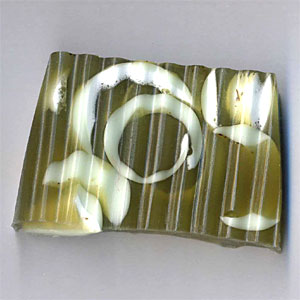 Invigorating Soap Bar
Invigorating Soap Bar
I chose the ingredients in this bar to use some of my peppermint harvest and being aware that cold and flu season is upon us I added some essential oils from a cold and flu blend I mixed up for my own use last year.
Will this soap bar help prevent colds and flu? Many culinary herbs and spices are antibacterial, so maybe. Some people have used anise, peppermint, cypress and patchouli to treat colds so this bar might help you feel a little better if you have a cold. Camphor is an ingredient in Vicks VapoRub15, which in childhood my Mom used to rub on me whenever I had chest congestion. Some of the ingredients are also in my energy and sore muscle blends, so it might be especially good to use in the morning before or after a workout. I'm not qualified to know anything for sure other than this combination of ingredients smells good in a slightly medicinal way and feels invigorating!
To make it first chop up a bunch of dried peppermint herb (I used stems after I had stripped off the leaves for tea) and put the pieces in a large microwave-safe measuring cup. Melt clear melt and pour soap base in the cup and pour the mixture into a clean plastic container and let it harden.
While you're waiting for that to harden, melt some opaque white melt and pour soap base and add a little green coloring to make a mint green color. Add essential oils in amounts recommended by the manufacturer and let harden. Cut the mint green soap with a melon-baller or other curl cutter of choice and put curls into a soap loaf mold.
Cut up the hardened soap/peppermint mixture and re-melt it. Strain out peppermint pieces and pour over soap curls. You will see that the peppermint herb has turned the clear base a pleasant green color. Let harden and cut into slices. Enjoy!
Ingredients: Melt and pour soap base, peppermint herb, anise essential oil, black pepper essential oil, camphor essential oil, cypress essential oil, juniper essential oil, patchouli essential oil, soap colorants.
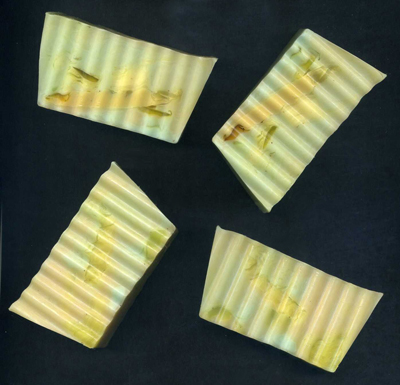 Scrap Soap Bar #1
Scrap Soap Bar #1
I've noticed that sometimes when doing ceramics that scrap glazes can be some of the best. I've made some great polymer clay beads with scrap canes and paper projects from scrap paper. I had some leftovers from my last several batches of soap so decided to make a scrap soap bar to see how it turned out. I'm really pleased with the results - the colors are nice together and I find the resulting fragrance blend much to my liking - warm and fresh, natural rather than "perfumy", not too strong. It's hard to say what it smells like but I would say orange and musk notes dominate.
Due to natural plant derived oil content, do not use before sun exposure, if pregnant or if you have epilepsy. Do not use on babies.
Ingredients: Melt and pour soap base, vitamin E capsules, patchouli essential oil, orange essential oil, palmarosa essential oil, patchouli fragrance oil, goats milk powder, annato, gardenia fragrance oil, hyacinth fragrance oil, Secret Garden fragrance oil, amber fragrance oil, sweetgrass fragrance oil, evening primrose oil, oatmeal, Fullers Earth, soap colorants, cooking spray for mold release, 70% isopropyl alcohol in a spray bottle.
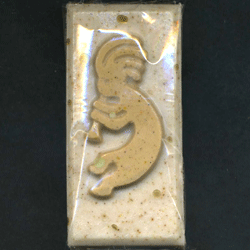 Santa Fe Ranch II Soap Bar
Santa Fe Ranch II Soap Bar
A good unisex or masculine color and fragrance combo.
Ingredients: Melt and pour soap base, contents of Vitamin E capsule (dl-Alpha Tocepheryl Acetate, Gelatin (Non-Bovine) Glycerin, Polysorbate 80, Water),
Yucca, Sandalwood and Sage Powders, Pine Forest, Leather and Sandalwood fragrance oils, Fir Needle and Gurjum Balsam essential oils, Polysorbate 20,
Zinc Oxide, Titanium Dioxide, Annatto, soap colorant, coconut cooking oil, 70% isopropyl alcohol.
Instructions:
- Melt some opaque white soap base and add colorants to make a medium warm brown color. I used brown soap colorant and ground Annatto spice. Annatto imparts a natural speckled look along with the yellow color. If you don't want speckles, you can use another type of yellow colorant.
- Take a Kokopelli soap mold and spray the cavities with cooking spray, then wipe of excess with a paper towel.
- Wait until the brown soap starts to get a skin on top (this ensures it's not so hot that it will melt the mold) and pour into the figure portion of the mold. Let
cool. If there are any drips you can remove them with an old credit card, blunt knife or similar tool.
- Spray the back of the brown soap figures with 70% isopropyl alcohol - this will help the next layer stick.
- Melt enough opaque white soap base to fill the remainder of your mold cavities. The amount you'll need will depend on the size of your mold. I used approximately 2 cups in my batch. Poke two Vitamin E gel capsules with a pin and squeeze in contents. Add 1/2 tsp each powdered sage, yucca root and sandalwood. Add fragrances and essential oils in amounts recommended by the manufacturer. I used Pine Forest FO, Leather FO, Sandalwood FO, Fir Needle EO and Gurjum Balsam EO. Add Polysorbate 20 to help everything blend together. After additives are in, if the color is too bright white for you, add a bit of leftovers from your brown batch to make a nice cream color.
- When soap starts to form a skin on top, make sure it's mixed well (to keep particles suspended) and pour into mold through fine-mesh strainer to catch any particles that are too large. Let cool and harden, then unmold. You're done!
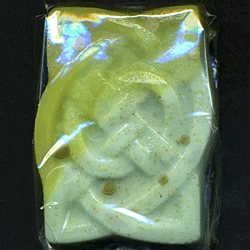 Green Fields Soap Bar
Green Fields Soap Bar
Fresh and light unisex fragrance.
Ingredients: Opaque white melt and pour soap base, contents of Vitamin E capsules (dl-Alpha Tocepheryl Acetate, Gelatin (Non-Bovine) Glycerin, Polysorbate 80, Water), soap colorant, Secret Garden soap fragrance, Sweetgrass fragrance, Palmarosa Essential Oil, Fuller's Earth, oatmeal, coconut cooking spray oil, 70% isopropyl alcohol.
Instructions:
- Coat Celtic soap mold with cooking spray for mold release. Wipe off excess oil with a paper towel.
- In one measuring cup, melt soap base and add Secret Garden fragrance in amounts recommended by the manufacturer, green soap coloring, powdered oatmeal and contents of 1 Vitamin E capsule. I usually add 1/2 tsp powdered additive per 1 cup of liquid soap.
- In another, melt some more soap base and add blue-green coloring, Sweetgrass FO, Palmarosa EO and some Fuller's Earth.
- Since you have added powders, it's a good idea to strain each color through a fine mesh strainer into a separate secondary container before the final pour to get rid of any possible lumps. You will be pouring both colors simultaneously, so try to get them both melted at the same time but they don't have to be exactly the same temperature as long as they are both liquid and not so hot that they melt the mold.
- Pour colors simultaneously into mold. Move pouring vessels around to increase swirl effect and stir after pouring for more pronounced swirl effect. As you can see I didn't get much swirl in my batch.
- Let cool and harden then remove from mold. You're done! Here is a good idea for decorating a muslin gift bag that would suit a soap made for a Celtic soap mold - Decorate a Celtic Gift Bag.
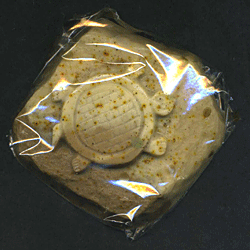 Animalistic II
Animalistic II
A good unisex or masculine color and fragrance combo.
Ingredients: Melt and pour soap base, contents of Vitamin E capsules (dl-Alpha Tocepheryl Acetate, Gelatin (Non-Bovine) Glycerin, Polysorbate 80, Water), Sandalwood Powder, Patchouli FO, Patchouli EO, Sandalwood FO, Gurjum Balsam EO, soap colorant, Annatto, 70% isopropyl alcohol in a spray bottle, coconut cooking spray oil.
Instructions:
- Spray Petroglyph Animals soap mold with cooking spray and wipe away excess with a paper towel.
- Melt two batches of opaque white melt and pour soap base and add contents of one Vitamin E capsule to each.
- In one batch, add brown soap coloring, ground Annatto spice, Sandalwood powder, Sandalwood FO and Gurjum Balsam EO.
- In the other batch, add Annatto spice for color and speckles, Patchouli EO, Patchouli FO and Goat's Milk Powder. Strain through a fine mesh strainer into a separate secondary container before the final pour to get rid of any possible lumps. You might be wondering why I used both Patchouli FO and EO in the same batch. The main reason is fragrance oils are sometimes more persistant than the essential oils and I like to boost the fragrance if I can while still using some essential oil for the beneficial properties. If you are interested in creating a 100% natural product then you would want to leave out the FO because fragrance oil formulas are proprietary and may contain artificial ingredients as well as natural ones.
- You will be pouring both colors simultaneously, so try to get them both melted at the same time but they don't have to be exactly the same temperature as long as they are both liquid and not so hot that they melt the mold. Pour colors simultaneously into mold. Move pouring vessels around to increase swirl effect and stir after pouring for more pronounced swirl effect. As you can see I didn't get much swirl in my batch.
- Let cool and harden then remove from mold. You're done!
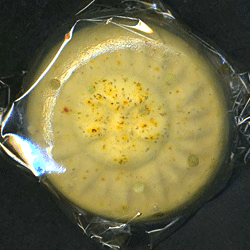 Golden Sunshine Soap Bar
Golden Sunshine Soap Bar
Warm, rich fragrance with a hint of orange. Ironically, do not use before sun exposure because the orange essential oil it contains (like all citrus oils) can cause photosensitivity.
Ingredients: Clear melt and pour soap base, opaque white and off-white melt and pour soap base, dried calendula petals, dried chamomille
flowers, contents Vitamin E capsules (dl-Alpha Tocepheryl Acetate, Gelatin (Non-Bovine) Glycerin, Polysorbate 80, Water), Annatto, Evening Primrose Oil, Amber fragrance oil, Orange essential oil, Coconut cooking spray oil, 70% isopropyl alcohol
Instructions:
- Melt a 1-cup glass measuring cup full of white melt and pour soap base, and add a small handful each of dried calendula petals and dried chamomille flowers. Let cool.
- Remelt herb-infused soap, and pour through a fine mesh strainer into another measuring cup. Add contents of two Vitamin E capsules,
and a tiny pinch anatto for extra color. Pour into sun mold. (Do not oil sun mold since these will be used as inserts.)
- Let cool and unmold sun inserts. Soap sometimes is difficult to unmold if mold is not oiled, stick mold in freezer if necessary to make soap easier to pop out.
- Spray plain molds with cooking spray for mold release and wipe off excess oil with a paper towel.
- Melt some clear melt and pour soap base and add orange essential oil, Amber fragrance oil in amounts recommended by the manufacturer. Add five drops of Evening Primrose oil.
- When soap starts to form a skin on top, fill plain mold cavities about 1/3 full of clear soap mixture and spray with 70% isopropyl alcohol. Add sun inserts and repositon if necessary with stick or skewer.
- Let soap harden sufficiently so that a new melted layer will not melt what is underneath. Spray with alcohol again and top off with more clear. Let sit until cool and hard then unmold. You're done!
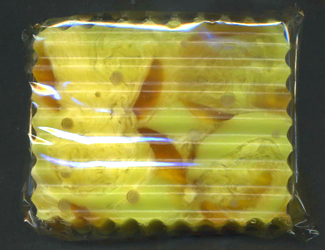 Flower Garden Soap Bar
Flower Garden Soap Bar
Welcome spring with floral scents in a swirled bar with embedded soap curls!
Ingredients: Clear melt and pour soap base, opaque white melt and pour soap base, soap colorants, contents of four Vitamin E capsules, Gardenia soap fragrance oil, Hyacinth soap fragrance oil, Secret Garden soap fragrance oil, cooking spray for mold release, 70% isopropyl alcohol in a spray bottle.
Instructions:
- Melt some clear melt and pour soap and add orange colorant and Hyacinth soap fragrance in amount recommended by the manufacturer. Pour into a clean plastic container and let harden.
- Melt some opaque white melt and pour soap, color it lime green and add Secret Garden soap fragrance. Pour into a clean plastic container and let harden.
- Choose a soap mold big enough to make about six 5 ounce bars. The ones I made in this batch measure roughly 3" x 2 1/2" x 1". I wanted to make rectangular bars, so I decided to use three clean rectangular Trader Joe's feta cheese containers. Oil your chosen mold with cooking spray if necessary and wipe off excess with a paper towel. The feta cheese containers I used are pretty flexible and easy to unmold so I did not oil the molds this time.
- Cut curls with curl-cutting tool of your choice (I used a melon baller) from the hardened orange and lime green soap and place in mold while alternating colors. Spray with 70% isopropyl alcohol between layers.
- Melt about a cup of clear soap base and add yellow color, the contents of two Vitamin E capsules, and Secret Garden fragrance.
- Simultaneously, melt about 2 cups of opaque white melt and pour soap base and add brown and yellow colorants in very small amounts to make a light yellow-cream color. Add Gardenia soap fragrance and the contents of two Vitamin E capsules.
- You will be simultaneously pouring the clear yellow and opaque cream yellow to make a swirl effect. They don't have to be exaclty the same temperature as long as they are both liquid. If you pour the soap too hot, it could melt the curls which can make a really nice swirl effect. If you don't want to melt the curls, wait until the liquid soap is just starting to form a skin on top.
- Simultanously pour both colors into the mold, and if you want a more pronounced swirl, move the cups around as you pour. If you don't move the cups around, you can get a two-tone effect.
- Let the mold sit undisturbed until the soap is hard. To be safe wait until the soap has cooled off completely and then wait some more. It will be worth the wait!
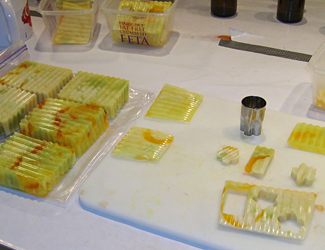 Unmold and slice the bars. I used a serrated cutter for mine. Because the sides of the feta cheese containers slope a bit, I had some leftover slabs after shaping the soap into rectangles. You can cut these slabs with metal cutters to use as inserts in future soap bars. Canape cutters, clay cutters and cookie cutters can all be used to make fun shapes to embed in clear bars.
Unmold and slice the bars. I used a serrated cutter for mine. Because the sides of the feta cheese containers slope a bit, I had some leftover slabs after shaping the soap into rectangles. You can cut these slabs with metal cutters to use as inserts in future soap bars. Canape cutters, clay cutters and cookie cutters can all be used to make fun shapes to embed in clear bars.
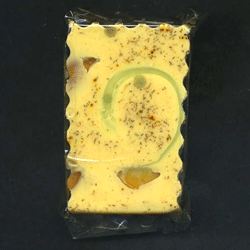 Garden Sunshine Soap Bar
Garden Sunshine Soap Bar
Very floral fragrance blend infused with real dried flowers for skin benefits.
Ingredients: Contents of Vitamin E capsules (dl-Alpha Tocepheryl Acetate, Gelatin (Non-Bovine) Glycerin, Polysorbate 80, Water), melt and pour soap base, soap colorant, Secret Garden soap fragrance, Hyacinth Soap Fragrance, dried calendula petals, dried chamomille flowers, ground Annatto, 70% isopropyl alcohol.
Instructions:
- Melt some clear melt and pour soap and add orange colorant and Hyacinth soap fragrance in amount recommended by the manufacturer. Pour into a clean plastic container and let harden.
- Melt some opaque white melt and pour soap, color it lime green and add Secret Garden soap fragrance. Pour into a clean plastic container and let harden.
- Cut curls with curl-cutting tool of your choice (I used a melon baller) from the hardened orange and lime green soap and place in chunky rectangular mold (oiled if necessary) while alternating colors. Spray with 70% isopropyl alcohol between layers.
- Melt a 1-cup glass measuring cup full of white melt and pour soap base, and add a small handful each of dried calendula petals and dried chamomille flowers. Let cool.
- Remelt herb-infused soap, and pour through a fine mesh strainer into another measuring cup. Add contents of two Vitamin E capsules,
and a tiny pinch Annatto for extra color. The dried flowers added quite a bit of fragrance on their own so I did not add any additional fragrance to the yellow portion. When soap starts to form a skin on top, pour into mold with curls.
- Unmold soap after it's completely cooled and hard. Cut apart with serrated soap cutter. You're done!
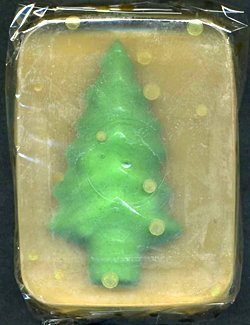 Christmas Tree Soap Bar
Christmas Tree Soap Bar
When I was young, my Mom made candy in this Christmas tree mold. This soap bar demonstrates how you can use candy molds to make inserts for clear melt and pour soap.
Ingredients: Clear melt and pour soap base, opaque white melt and pour soap base, Goat's Milk Powder, Jack Frost soap fragrance oil, Fir Needle essential oil, Sandalwood soap fragrance oil, Gurjum Basalm essential oil, cooking spray for mold release, 70% isopropyl alcohol in a spray bottle.
Instructions:
- Melt some opaque soap base and add green coloring. A common problem with inserts for clear soaps is that dye type soap colorants can leach into the clear over time. To avoid this, use pigment-type colorants for inserts.
- Pour green mixture into Christmas tree candy mold. My candy mold is from the 1970s and is pretty stiff and is not easy to unmold. Oiling a stiff mold helps in unmolding later, but since I'm making inserts here I don't want to oil the mold because the oil will hinder the insert from sticking to the soap I'm going to pour around it later. Stick a mold such as this into the freezer before unmolding, that will help greatly with mold release.
- Unmold Christmas trees. Choose a mold for the finished bars. A mold with a smooth surface is best for showing inserts under clear. Rectangles and ovals work well for these trees.
- Oil the mold cavities with cooking spray and wipe off excess with a paper towel.
- If your mold does not sit flat and level on the work surface, balance the mold on the bottoms of four identical upturned shot glasses (or any four small objects with flat bottoms of identical height) to keep the mold as stable and level as possible. It will make the pouring a lot easier.
- Melt some clear soap base and add Jack Frost fragrance oil and Fir Needle essential oil in amounts recommended by the manufacturer.
- When the soap starts to form a skin on top, remove the skin then fill one of the bar cavities 1/3 full of the clear mixture. Spray with alcohol to break any bubbles that might be on the surface. Add a tree insert and push down into the clear if one end floats up. Repeat for each cavity. Let bars sit until the first pour layer is solid.
- To add another layer and finish up the bars, spritz with the alcohol or Bubble Buster, and melt some opaque white melt and pour soap and add Goat's Milk Powder (optional), Sandalwood fragrance oil and Gurjum Balsam essential oil in amounts recommended by the manufacturer. Fill the rest of the mold cavities with this mixture.
- Let the mold sit undisturbed until the soap is hard. To be safe wait until the soap has cooled off completely and then wait some more. It will be worth the wait!
- Pop the bars out of the mold and enjoy!
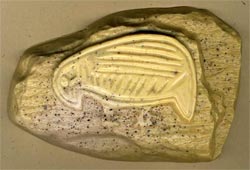 Animalistic
Animalistic
This project used the Petroglyph Animals mold by Milky Way molds and makes 8 bars.
Ingredients: Allspice FO, Patchouli FO, Spiced Bay FO, Woodsmoke FO, Hazelnut FO, Vetivert EO, Cypress EO, Clary Sage EO, Cedar EO, opaque white melt and pour soap base, ground nutmeg, soap colorants, cooking spray.
Instructions:
- Lightly spray the soap mold with cooking spray and wipe with paper towel to remove the excess.
- Mix a blend of fragrance oils in the following proportions: 1 part Allspice FO, 1 part Patchouli FO, 1 part Spiced Bay FO, 8 parts Woodsmoke FO and 16 parts Hazelnut FO. Mix another blend of essential oils in the following proportions: 1 part Vetivert, 1 part Cypress, 2 parts Clary Sage, and 2 parts Cedarwood.
- Melt 1 1/2 cups (quantity is after melting) of opaque white melt and pour soap base in one microwaveable glass measuring cup, and melt the same amount in another microwaveable glass measuring cup. Color one batch ochre yellow and one light brown. Add 1/4 tsp ground nutmeg to each batch. Add 30 drops of the first fragrance blend to one, and 20 drops to the other.
- Try to keep both cups close to the same temperature, but they don't have to be exact. When a skin starts to form on top, pour both colors simultaneously into each mold cavity. Swirl a stick once in each cavity to mix colors slightly.
- Unmold bars and repeat until you have used all the soap you mixed up.
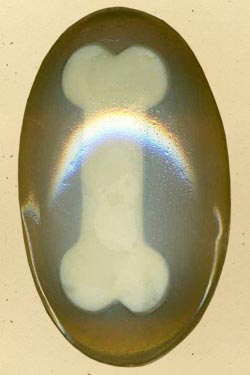 Dog Soap Bar
Dog Soap Bar
Flea-repelling soap with a cute dog bone suspended in clear soap base. Safe for human use too as an antibacterial and insect-repelling soap bar. NOT FOR USE ON CATS.
Ingredients: Clear melt and pour soap base, opaque white and off-white melt and pour soap base, Desert Essence Tea Tree Oil , Peppermint essential oil, cooking spray for mold release, 70% isopropyl alcohol in a spray bottle. , Peppermint essential oil, cooking spray for mold release, 70% isopropyl alcohol in a spray bottle.
Instructions:
- Line a glass baking dish with aluminum foil. Fill to a depth of about 1" with small pieces of white and off-white opaque soap base.
- Turn your oven on it's lowest setting. Put the baking dish full of soap pieces in, and check it about every five minutes until the soap melts enough to slump into a flat mass, melted just enough to be mostly flat, but not melted so much that the interesting confetti effect disappears. In my oven this took about 10 minutes.
- Carefully remove the baking dish and allow to cool until the soap has cooled and hardened.
- Turn the baking dish over onto a clean cutting board to let the contents fall out, and peel the foil away. Now you have a flat slab of soap that is ready to be cut into inserts. Decide whether the top or bottom is the most interesting (I find it's usually the top) and lay the slab on the cutting board with the interesting side up.
- With the medium sized cutter from the Fox Run Dog Bone Cookie Cutter Set
 , cut shapes out of the slab and set aside. , cut shapes out of the slab and set aside.
- Select a soap mold that you like to use for clear bars with inserts - usually one with individual bar cavities and a plain smooth surface. I used an oval mold for my bars.
- Lightly spray the insides of the cavities of your mold with cooking spray. Wipe out the excess cooking spray with a paper towel. If your mold does not sit flat and level on the work surface, balance the mold on the bottoms of four identical upturned shot glasses (or any four small objects with flat bottoms of identical height) to keep the mold as stable and level as possible. It will make the pouring a lot easier.
- Melt some clear soap base and add Peppermint and Tea Tree essential oils in amounts recommended by the manufacturer.
- When the soap starts to form a skin on top, remove the skin then fill one of the bar cavities 1/3 full of the clear mixture. Spray with alcohol or Bubble Buster to break any bubbles that might be on the surface. Add a soap bone and push down into the clear if one end floats up. Repeat for each cavity. Let bars sit until the first pour layer is solid.
- To add another layer and finish up the bars, spritz with the alcohol or Bubble Buster, and add more clear.
- Let the mold sit undisturbed until the soap is hard. To be safe wait until the soap has cooled off completely and then wait some more. It will be worth the wait!
- Pop the bars out of the mold and enjoy!
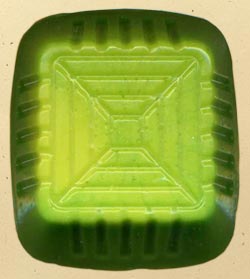 Bayberry and Vanilla Soap Bar
Bayberry and Vanilla Soap Bar
A simple technique that does not take away from the detailed mold, with a scent that is particularly nice at Christmas time.
Ingredients: Clear melt and pour soap base, opaque white melt and pour soap base, bayberry fragrance, vanilla fragrance, soap colorants, cooking spray for mold release.
Instructions:
- Choose a fairly detailed soap mold and lightly spray with cooking spray. I used a geometric candy mold for this example. Wipe away the excess oil with a paper towel.
- Mix two batches of soap base - one lime green and one a darker grass green. Adding some clear with the opaque makes a pleasant translucent effect. My lime green mix was about 1/4 clear and my darker green mix 1/2 clear.
- In amounts recommended by the manufacturer, add bayberry fragrance to one color and vanilla to the other.
- Simultaneously pour both colors into the mold cavities.
- Let the mold sit undisturbed until the soap is hard. To be safe wait until the soap has cooled off completely and then wait some more. It will be worth the wait!
- Pop the bars out of the mold and enjoy!
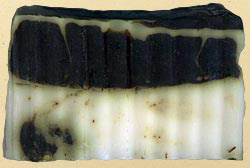 Antibacterial Soap Bar
Antibacterial Soap Bar
I have a lot of hobbies that require washing my hands frequently - for example aquarium keeping, gardening, and taking care of my pet bird Atilla. I wanted some soap that is antibacterial, slightly abrasive for deep cleaning, and also kind to my skin. This batch of soap succeeded admirably for it's intended purpose, except for the swirl effect I was trying to add. I'm not even going to describe how I tried to do the swirl because it obviously didn't work, but the results have a rugged look that I find pleasing.
Ingredients: Clear melt and pour soap base, opaque melt and pour soap base, green coloring, dried eucalyptus leaves, Polysorbate 20, Goat Milk Powder, Stearic Acid, Eucalyptus essential oil, Desert Essence Tea Tree Oil . .
Instructions:
- To make the green batch, put a small handful of eucalyptus leaves into a spice grinder and grind into a powder.
- Melt some clear melt and pour soap base, and add green coloring and the eucalyptus powder. Set aside.
- To make the white batch melt some opaque melt and pour soap base, and add, in amounts recommended by the manufacturer, Polysorbate 20, Goat Milk Powder, Stearic Acid, Eucalyptus essential oil, and tea tree essential oil.
- Remelt the green batch and try to get the green and white batches ready to pour and roughly the same temperature. They don't have to be exactly the same temperature, just liquid and pourable.
- Pour both colors simultaneously into a rectangular loaf mold.
- Let the mold sit undisturbed until the soap is hard. To be safe wait until the soap has cooled off completely and then wait some more. It will be worth the wait!
- Pop the bars out of the loaf mold and slice with a serrated cutter. Enjoy!
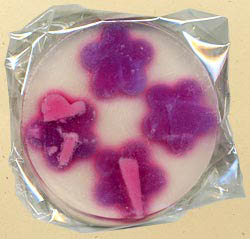 Embedded Confetti Flowers Soap Bar
Embedded Confetti Flowers Soap Bar
Here is a slightly different take on making inserts for clear melt and pour soap. If you've been making soap for awhile, particularly if you mix up batches of colors for loaf soap inserts, you probably have odds and ends of colors left over. I'll explain how to use them to make interesting inserts for clear soap bars.
Ingredients: Clear melt and pour soap base, opaque melt and pour soap base, leftover chunks of colored soap from previous projects, Lavender Fragrance Oil, Vanilla Lavender Fragrance Oil, cooking spray for mold release, 70% isopropyl alcohol in a spray bottle or Bubble Buster.
Instructions:
- Line a glass baking dish with aluminum foil. Fill to a depth of about 1" with pieces of colored soap, both clear and opaque, left over from previous soap projects. If you don't have leftover pieces available, you can mix up three or more batches of color, let harden, then cut them up and put them in the baking dish.
- Turn your oven on it's lowest setting. Put the baking dish full of soap pieces in, and check it about every five minutes until the soap melts enough to slump into a flat multicolored mass, melted just enough to be mostly flat, but not melted so much that the interesting multicolored confetti effect disappears. In my oven this took about 10 minutes.
- Carefully remove the baking dish and allow to cool until the soap has cooled and hardened.
- Turn the baking dish over onto a clean cutting board to let the contents fall out, and peel the foil away. Now you have a flat slab of soap that is ready to be cut into inserts. Decide whether the top or bottom is the most interesting (I find it's usually the top) and lay the slab on the cutting board with the interesting side up.
- With the metal pastry, canape, or cookie cutters of your choice, cut shapes out of the slab and set aside. Plastic cookie cutters are not sturdy enough to cut the soap without breaking.
- Select a soap mold that you like to use for clear bars with inserts - usually one with individual bar cavities and a plain smooth surface. Here are links to some examples of suitable molds for this project:
- Lightly spray the insides of the cavities of your mold with cooking spray. Wipe out the excess cooking spray with a paper towel. If your mold does not sit flat and level on the work surface, balance the mold on the bottoms of four identical upturned shot glasses (or any four small objects with flat bottoms of identical height) to keep the mold as stable and level as possible. It will make the pouring a lot easier.
- Melt some clear soap base and add fragrances in amounts recommended by the manufacturer. I used one part Lavender and one part Vanilla Lavender.
- When the soap starts to form a skin on top, remove the skin then fill one of the bar cavities 1/3 full of the clear mixture. Spray with alcohol or Bubble Buster to break any bubbles that might be on the surface. Add some of the cut out insert pieces. Repeat for each cavity. Let bars sit until the first pour layer is solid.
- To add another layer and finish up the bars, spritz with the alcohol or Bubble Buster, and add a layer of a contrasting color or more clear. I used a pearly white in my sample.
- Let the mold sit undisturbed until the soap is hard. To be safe wait until the soap has cooled off completely and then wait some more. It will be worth the wait!
- Pop the bars out of the mold and enjoy!
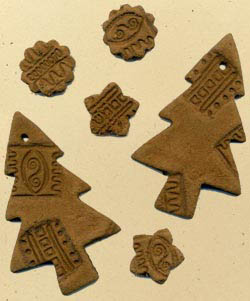 Wood and Spice Fragrance Pastilles and Car Air Freshener Trees
Wood and Spice Fragrance Pastilles and Car Air Freshener Trees
I was first introduced to salt dough in preschool, where we made ornaments for Christmas. It became a favorite craft material of mine throughout childhood. In recent years, I've experimented with using salt dough for making fragrant ornaments and pastilles to add to potpourri mixes. In my opinion this is my most successful batch so far.
Ingredients:
Instructions:
- Crumble the dried Sage leaves into a glass microwave-safe measuring cup. Add 1 cup of water, and heat in the microwave for approximately three minutes.
- Add all the other dry ingredients except for the Sandalwood powder to a large bowl that can withstand having near-boiling water poured into it. Mix well.
- Remove the measuring cup from the microwave, and strain out the sage pieces while pouring 2/3 of the water in the cup into the bowl of dry ingredients. Mix dough together, adding more of the sage-infused water if it is needed to make the dough workable.
- Sprinkle some Sandalwood powder on a flat work surface, as you would lay down flour when making cookies or pie crust. Sprinkle more Sandalwood powder on top, and roll dough out with a rolling pin, to somewhere in the vicinity of 1/8 to 1/4 inch thick.
- Apply more Sandalwood powder to the top of the dough, then stamp randomly with decorative rubber stamps. For my samples, I used these stamps from Carolyn's Stamp Store: Line Drawing with Double Spiral, Line Drawing with Squigglies and Shape Stripes.
- If you want to make tree-shaped car air fresheners, cut out tree shapes with a cookie cutter. If you want to make fragrance pastilles or fragrant ornaments, cut out shapes of your choice with cookie cutters or canape cutters. Poke a hole toward the top of any shapes that you want to attach a hanging loop too. Place finished cutout shapes on a cookie sheet to dry.
- When the dough shapes are completely dry, which will probably take several days, brush any excess Sandalwood powder off with a clean paintbrush and store shapes in a plastic zip-lock bag until you're ready to use them.
- For ornaments or air fresheners, attach a hanging loop with cord. You can embellish the cord with beads if you want to.
- The fragrance pastilles can be used alone or added to a potpourri mix such as the one below. Make sure they are safely away from anyone who might mistake them for edible cookies!
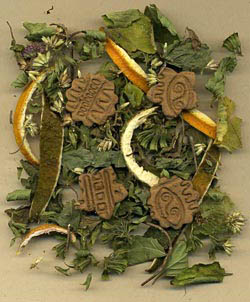 Basil and Citrus Potpourri
Basil and Citrus Potpourri
Ingredients: Dried leaves of Rosemary, Lemon Balm, Lime Balm, Korean Hyssop, Red Rubin Basil and Sweet Basil, Rosemary Essential Oil, Lemon Essential Oil, Basil Essential Oil, Lemongrass Essential Oil, Juicy Lime Fragrance Oil, Orange Essential Oil (Citrus aurantium), lemon peel, lime peel, orange peel and Wood and Spice Fragrance Pastilles.
Instructions:
- Grow or otherwise obtain two handfuls of each of the following dried leaves: Rosemary, Lemon Balm, Lime Balm, Korean Hyssop, Red Rubin Basil and Sweet Basil. The herbs I used for this particular batch were home-grown. Put the leaves into a large container that has a tight-fitting lid.
- Add several drops of each essential and fragrance oil and shake or stir the contents. Smell the mixture and see if it is strong enough. If it's not, repeat until you are satisfied with the fragrance.
- Peel several limes, lemons, and oranges. Cut the peels into thin strips and set out on a cookie sheet for several days to dry. When the peels are throughly dry, add them to your mix. If you need a use for the juice of the lemons and limes, here is a tasty cookie recipe.
- Optional: Display potpourri in an open decorative container and place a few fragrance pastilles on top.
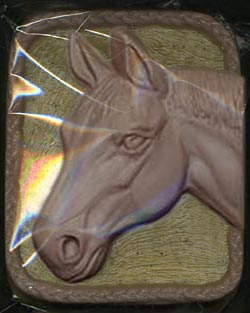 On The Santa Fe Trail Soap Bar
On The Santa Fe Trail Soap Bar
An exfoliating bar with a fragrance that will take your imagination on a trail ride on the High Plains!
Ingredients: Natural White MP Soap Base, cooking spray for mold release (soybean oil, soy lecithin, water, propellant), Polysorbate 20, Leather fragrance oil, cosmetic grade colorants, home grown yucca root, home grown sage (salvia officinalis), Fruit Fresh (Dextrose, Ascorbic Acid (Vitamin C), Citric Acid, Silicon Dioxide), 70% isopropyl alcohol and Bubble Buster.
Instructions:
- Spray the insides of the cavities of a Horse soap mold with cooking spray. Wipe out the excess cooking spray with a paper towel. Balance the horse mold on the bottoms of four identical upturned shot glasses (or any four small objects with flat bottoms of identical height) to keep the mold as stable and level as possible. It will make the pouring a lot easier.
- On the first pour we'll fill in only the details of the horse portrait and rope border. Melt some opaque white soap base, and color with brown soap coloring to make light brown. Add leather fragrance and Polysorbate 20 in amounts recommended by the manufacturer. Pour into the horse soap mold filling only the horse and rope portions of the design. Let this layer harden.
- While the light brown pour is hardening, grind some dried yucca root pieces and dried sage pieces in spice grinder as finely as you can get them. Sift the ground pieces through a fine meshed strainer to remove any large pieces that might remain to get a fine powder to add to your soap. Discard the sifted out large pieces or save them to use for something else.
- When the light brown layer is hard enough to handle without damage, inspect your pour for any light brown drips or spills that are outside the rope and horse portions of the mold. You might be skilled enough not to have any drips where you don't want them, but I'm not! If there are any, you can remove them by cutting around them with the tip of a knife that is not sharp enough to damage the mold, and gently pulling the unwanted pieces up. They should come up easily due to the earlier application of the cooking spray. Some unwanted bits might come up more easily by scraping them with a piece of cut-up credit card.
- Melt some more opaque white soap base, and color it a light tan-yellow color. Make sure it's lighter enough in color than the brown layer to create enough contrast to show the design. Add Polysorbate 20 and Leather fragrance in amounts recommended by the manufacturer. Add approx 1/4 tsp Fruit Fresh and 1 TBSP combined yucca root and sage powder to about 1 1/2 cups of melted soap.
- Spray the brown pour layer with alcohol or Bubble Buster, and fill the remaining space in the mold cavities with the light yellow mixture.
- Let the bars cool, then unmold and enjoy.
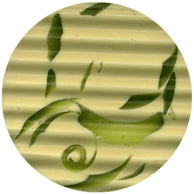 Cream of Celery Soap Bar
Cream of Celery Soap Bar
A fresh green color and fragrance will cheer you as you wash if you can't wait for spring to get here!
Ingredients: Commercial crafting soap base (Life of the Party Cool Soap Base, Life of the Party Avocado Cucumber Soap Base, Soapcrafters Glycerin Melt & Pour Clear), celery, contents of vitamin E capsule, Polysorbate 20, Rosemary Oleoresin Extract (ROE), Sweetcakes Fresh Grass Fragrance, Germaben II, Fuller's Earth, cosmetic grade colorants. Canola Harvest cooking spray used for mold release.
Tools and supplies:
Glass measuring cups
Plastic food storage containers, including one wide flat one
Strainer
Clean empty plastic tubes from powdered drink mix packaging
Scissors that can cut plastic
Rubber bands
Plastic wrap
Aluminum foil
Cutting board
Knife
Paper Towels
Tray with raised edge
Melon baller or curl-cutting tool of choice
Serrated soap cutter
Soap cutting mitre box
Instructions:
- Wash and chop up a handful of fresh celery parts. Melt 1/4 package of opaque melt and pour soap base with the celery parts in a glass measuring cup. I used Life of the Party Avocado Cucumber Soap Base. Cover the measuring cup with foil or plastic wrap, and let it sit in the refrigerator overnight.
- Next make a batch of clear green soap for cutting curls. I used Soapcrafters clear melt and pour glycerin base mixed with Life of the Party Cool Soaps green for color, and poured it into a 6-cup flat rectangular plastic food storage container. The wide flat shape makes it easy to cut curls from the hardened soap. If you don't have green soap base to mix with the clear like I did, use soap colorants to make the clear soap base green.
- The next day, remove the cup with the celery-infused soap from the refrigerator, and remelt it. Pour the mixture through a strainer into another container for temporary storage, and discard the celery bits. Melt more opaque soap base and add the following: contents of one vitamin E capsule, ROE, Germaben II, Fuller's Earth and Polysorbate 20. Refer to manufacturers' recommendations for amounts of the additives. Leave out the Fuller's Earth if you have dry skin. Pour the mixture into a container for temporary storage. You will eventually be mixing this with the celery/soap mixture, so it can go into the same container.
- Cut the ends off of some powdered drink mix tubes. Spray the insides of the tubes with Canola non-stick cooking spray and wipe off the excess with a paper towel. Cover one end of each tube with a square of plastic wrap followed by a square of foil, then secure with a rubber band. When you pour the soap into these tube molds, there will probably not be any leaks, but just in case there are stand the tubes covered end down into some kind of receptacle or tray with a lip or raised edge to prevent spills.
- Using a melon baller or other tool you like for cutting soap curls, cut curls from the large block of clear green and drop them into the tubes. If you use a melon baller, you don't have to remove the soap block from the food container while you cut.
- Remelt the opaque soap base infused with celery and with the additives, and add Fresh Grass fragrance in amounts recommended by the manufacturer. Stir gently to minimize air bubbles. When the soap begins to form a skin on top, remove the skin and pour slowly and steadily into the tubes. As each tube is full, tap the sides to encourage any air bubbles to float to the surface.
- Let cool, push out of the molds, then slice with the serrated cutter for extra visual interest.
Possible Improvements for Next Time:
Over time, the green from the celery turned a light brown. I might try adding Fruit Fresh if I make this again to see if it helps it to stay green. Perhaps a hint of artificial green color in the lighter green part will help disguise that also. I added the celery because I liked the color and fragrance, perhaps some cucumber could be added as well because it has benefits for the skin. And next time I would put two different colors of green curls instead of just one to add more visual interest - such as a medium celery green like you see in the sample plus a darker cucumber-ish green.
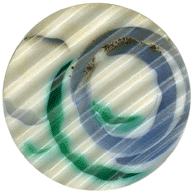 Oceanic Soap Bar
Oceanic Soap Bar
Ingredients: Commercial crafting soap base (Life of the Party Cool Soap Base, Soapcrafters Glycerin Melt & Pour Clear, and Crafters Choice Natural White Melt and Pour Soap Base), Polysorbate 20, contents of vitamin E capsules, kelp, Sweetcakes Juicy Lime Fragrance, Soap Wizards Ocean Fragrance, Soapcrafters Ocean Fragrance, Rosemary Oleoresin Extract (ROE), food grade vanilla extract (vanilla bean extractives in water, alcohol, corn syrup), cosmetic grade colorants. Canola Harvest cooking spray used for mold release.
Sea Shell Guest Soaps
Ingredients: Commercial crafting soap base (Life of the Party Cool Soap Base, Soapcrafters Glycerin Melt & Pour Clear, and Crafters Choice Natural White Melt and Pour Soap Base), Polysorbate 20, contents of vitamin E capsules, kelp, Sweetcakes Juicy Lime Fragrance, Soap Wizards Ocean Fragrance, Soapcrafters Ocean Fragrance, Rosemary Oleoresin Extract (ROE), food grade vanilla extract (vanilla bean extractives in water, alcohol, corn syrup), cosmetic grade colorants. Canola Harvest cooking spray used for mold release.
Foot Scrub Bar
Ingredients: Commercial crafting soap base (Life of the Party Cool Soap Base, Soapcrafters Glycerin Melt & Pour Clear, and Crafters Choice Natural White Melt and Pour Soap Base), Polysorbate 20, contents of vitamin E capsules, kelp, Sweetcakes Juicy Lime Fragrance, Soap Wizards Ocean Fragrance, Soapcrafters Ocean Fragrance, Rosemary Oleoresin Extract (ROE), food grade vanilla extract (vanilla bean extractives in water, alcohol, corn syrup), Tea Tree Oil , cosmetic grade colorants. Canola Harvest cooking spray used for mold release. , cosmetic grade colorants. Canola Harvest cooking spray used for mold release.
Relaxing Rose Bath Salts
Ingredients: Baking soda, Epsom salt, Dead Sea salt, Amber FO, Rose FO, essential oils of Orange, Cedarwood, Bergamot, Patchouli, Basil, Palmarosa, Rosemary, Lemongrass and Lavender, yellow and peach liquid soap coloring.
Instructions: In a large glass or ceramic mixing bowl, place 1 cup baking soda, 2 cups Epsom salt, and 1 cup Dead Sea salt. Mix well. Make a blend of the essential oils and store in a glass bottle with clear labeling. In a small glass or ceramic bowl, put three drops of yellow soap coloring and five drops of peach soap coloring. Add 20 drops of the essential oil blend, 20 drops of Amber FO and 57 drops of Rose FO. Mix well and pour into salt mixture. Swirl some salt around in the small dish to collect all the dye/fragrance mixture and add back to large bowl. Mix well and break up any lumps with a fork.
Relaxing Bath Salts
Ingredients: Orange EO, Cedarwood EO, Bergamot EO, Patchouli EO, Basil EO, Palmarosa EO, Rosemary EO, Lemongrass EO, Lavender EO, baking soda, coarse sea salt, Dead Sea salt.
Instructions: Mix up a bend of the essential oils listed and store it in a glass container. In a medium sized mixing bowl, add 1 cup baking soda, 1 cup coarse sea salt, and 1/2 cup Dead Sea salt. Add two eyedroppers full of the essential oil mixture and mix well. Break up any lumps with a fork.
Foot Soak Bath Salts II
Ingredients:
Directions:
Combine all ingredients in a small glass mixing bowl. Use a fork to break up any lumps. Stir and break up lumps periodically for a day or two until mixture is dry. Store in a closed glass container. Dissolve about a 1/4 cup in a basin of hot water and soak your feet whenever they feel like they need a bath, after a hike for example. I don't know how it makes your whole body feel good, not just your feet, but it does.
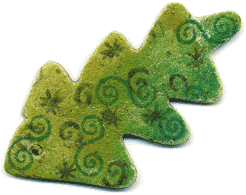 Salt Dough Leaf Ornament
Salt Dough Leaf Ornament
I like to make these to tie onto my gift packages. It makes the gift look more festive plus the recipient can later hang it in a closet or some other place where they would want a nice scent.
Ingredients: Chopped dried herbs (sage, rosemary, and spearmint), flour, salt, wallpaper paste, food coloring, Northwoods fragrance oil, Cedarwood essential oil, watercolor paints and crayons, dye-based rubber stamp ink. The double spiral rubber stamp is from my own collection.
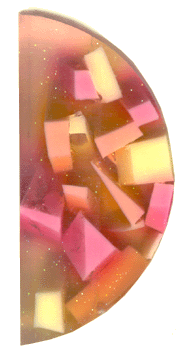 Berry Good Soap Bar
Berry Good Soap Bar
Ingredients: Commercial crafting soap base (Life of the Party Moisturizing Clear Glycerin Soap, Soapcrafters Opaque Glycerin, and Crafters Choice Natural White Melt and Pour Soap Base), Polysorbate 20, bayberry fragrance, vanilla fragrance, strawberry fragrance, and pearberry fragance, cosmetic grade colorants.
Canola Harvest cooking spray used for mold release. 70% rubbing alchohol used for soap layer adhesion and bubble reduction.
Instructions:
- Mix three color batches of approx. 1/2 cup to 3/4 cup each. Start with white opaque melt and pour soap base and add colorants of your choice. For this project I used yellow-green (which looks all yellow in the finished bar), peach, and magenta. Pour each color into a separate container and let harden. You can use soap molds for this, or in order to save wear and tear on your soap molds, use clean plasic food containers.
- Get your loaf soap mold and spray the inside lightly with cooking spray. Wipe off the excess with a clean paper towel. For this project I used the loaf mold made by Life of the Party.
- Place the mold on some kind of support that will keep it from rolling or moving while the soap is hardening. Sets of cups of matching height work well, an old ice tray is also handy for this.
- When your colors are hardened through, cut them into chunks. Try to vary the size and shape as you cut.
- Fill the loaf mold with chunks, distributing the colors as much as you can. Fill the mold all the way to the top. It's okay if pieces project higher than the top of the mold - you can trim those pieces off later if you want. At about 1/3 full, spritz the chunks with alchohol or Bubble Buster. Repeat at 2/3, and again when full.
- Melt enough clear melt and pour base to fill a 2-cup measuring cup. Add some opalescent soap glitter, and one drop of red or magenta liquid soap color. I used about 1/4 tsp to 1/2 tsp Polysorbate 20 to theoretically help keep the soap glitter suspended. It's usually used for helping things like fragrance and water mix together, but on a whim I added some to see if it would help suspend the glitter since I read that it helps to disperse things. I'm no chemist as you can tell! I'd have to do another similar batch without it to see if it actually did anything. Stir slowly to avoid adding excess air bubbles.
Add the fragrance:
Refer to the manufacturers instructions for guidance on amounts.
2 Parts bayberry FO
1 Part pearberry FO
1 Part strawberry FO
1 Part vanilla FO
- When the mixture is mixed fully, and starts to cool enough to form a skin on top, remove the skin with a spoon, set it aside, and pour the rest of the mixture into the mold. Pour slowly and steadily until the mold is full. Gently tap the sides to dislodge any bubbles and allow them to float to the top. Use the alchohol or Bubble Buster to break bubbles on the surface.
- Let the mold sit undisturbed until the soap is hard. Such a large chunk of soap might take several hours to harden completely. To be safe wait until it has cooled off completely and then wait some more. It will be worth the wait!
- Pop the loaf out of the mold, slice, and enjoy!
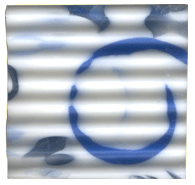 Icy Clean Soap Bar
Icy Clean Soap Bar
Ingredients: Commercial crafting soap base (Life of the Party Moisturizing Clear Glycerin Soap and Avocado Cucumber opaque soap base, Soapcrafters Opaque Glycerin, and Crafters Choice Natural White Melt and Pour Soap Base), Life of the Party "Spa" fragrance (I don't know what they really call it but it came with the Spa Indulgence embossed soap bar kit), Life of the Party Spruce fragrance, cosmetic grade colorants.
Canola Harvest cooking spray used for mold release. 70% rubbing alchohol sprayed on for soap layer adhesion and bubble reduction.
Instructions:
- Mix up and harden up two or three batches of colors to use for inserts. For the soap pictured I made a batch of opaque pale blue, a batch of clear darker blue with dark blue coloring and blue irridescent powdered color, and a third batch made of leftovers from the first two mixed together and fortified with more blue coloring.
- Choose a large container to use as a mold. A plastic storage box or a loaf mold would be a good choice. Spray the inside of the container lightly with cooking spray, and wipe off the excess with a paper towel.
- After the color chunks are hard, cut curls from them. The size and shape of the curls will depend on the size of the soap chunks and tool you use for the cutting. For the soap you see in the picture, I used the large end of a melon baller to cut out the curls.
- Place the curls in the mold, mixing up the colors as well as you can. Spray from time to time with a rubbing alcohol spritz or Bubble Buster.
- Fill a 2-Cup glass measuring cup with melted white opaque melt and pour soap base. Add a bit of white pearlized powder colorant. Add the fragrance:
Refer to the manufacturers instructions for guidance on amounts.
1 part Spruce fragrance
1 part "Spa" fragrance
- When the mixture is mixed fully, and starts to cool enough to form a skin on top, remove the skin with a spoon, set it aside, and pour the rest of the mixture into the mold. Pour slowly and steadily until the mold is full. Gently tap the sides to dislodge any bubbles and allow them to float to the top. Use the alcohol or bubble buster to break bubbles on the surface.
- Let the mold sit undisturbed until the soap is hard. Such a large chunk of soap might take several hours to harden completely. To be safe wait until it has cooled off completely and then wait some more. It will be worth the wait!
- Pop the loaf out of the mold, slice, and enjoy!
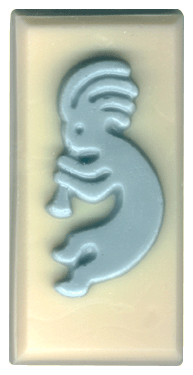 Santa Fe Ranch Soap Bar
Santa Fe Ranch Soap Bar
Ingredients: Commercial crafting melt and pour soap base, food grade vanilla extract, soap fragrance (My notes on this one are more vague than I'd like but it's probably Woodsmoke, Sweetgrass, and Desert Sage), cosmetic grade colorants.
Helpful Hint #2 - Why did I use food grade vanilla extract in this soap bar? In this case it's because I wanted the white soap that forms the background for the Kokopelli figure to be more creamy white and not stark bright white. Vanilla extract will give a nice hint of color, and a very small hint of fragrance that is not likely to clash with anything. The food grade vanilla extract is not strong enough to make much of a vanilla fragrance on it's own, if I was aiming for a strong vanilla fragrance I would use a vanilla soap fragrance with it. Many vanilla fragrances reportedly also discolor soap, so if you're not sure if yours does, do a small test first.
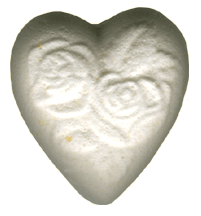 Bath Fizzies
Bath Fizzies
Bath Fizzies are like big Alka Seltzer tabs for your bath.
Ingredients:
1 1/2 cups of Baking Soda
1/2 cup of Citric Acid
Witch Hazel in a fine mist sprayer
Fragrance or essential oils of your choice
Powdered or liquid colorants of your choice
Cooking spray for mold release
First, put baking soda and citric acid in a large bowl. If you're using powdered colorant, add it and mix dry ingredients well. If you are using liquid colorant, add it, mix and break up any lumps that form. Add whatever fragrance or essential oils you want, using your nose as guide to how much to add, mix, and break up any lumps that form. Repeat until there are no more lumps.
Prepare your mold by spraying lightly with cooking spray and wiping with a paper towel to remove the excess oil. Begin wetting down the mixture by spraying witch hazel into the bowl and mixing with a spoon. Spray about three or four times, mix and check consistency. Repeat until mixture just barely starts to clump together. Be careful not to add too much Witch Hazel at one time, if you add too much the mixture will start to fizz too early. Pack mixture into mold cavities, pop out after about 10 minutes and spritz with a little Witch Hazel to harden up the surface. Store in a dry place until ready to use.
 Coffee Soap Bar
Coffee Soap Bar
Ingredients: Commercial crafting melt and pour soap base, some leftovers from Honey and Oatmeal soap above, food grade vanilla extract, vanilla fragrance, hazelnut fragrance, coffee bean fragrance (Soap Crafters), dark portion infused with flavored hazelnut cream coffee (arabica coffee beans, malt extract, nut extract, vanillin, artificial hazelnut flavor).
And by mixing leftovers from Honey and Oatmeal and Coffee together, I ended up with Coffee Dessert!
Lime Delight Soap Bar
Ingredients: Commercial crafting soap base (the clear portion is Crafter's Choice Extra Clear), fragrance (Masculine Musk, Green Tea (Soap Crafters), Leather, Juicy Lime, Coconut, and Amber), cosmetic grade colorants.
Canola Harvest cooking spray used for mold release. 70% rubbing alchohol sprayed on for soap layer adhesion and bubble reduction.
- Mix up a small batch of opaque lime green soap and add some complementary pearlized powders. Pour the mixture into the cavities of a citrus slices mold. The flexible mold I used was sold as an ice cube tray, and although I'm not sure if they are exactly the same, I've seen similar molds on a soap supply web site.
- Get a multi cavity bar soap mold and spray it lightly with cooking spray. Wipe off the excess with a clean paper towel. I used a mold of two circles and two ovals made by Life of the Party.
- Place the mold on some kind of support that will keep it from rolling or moving while the soap is hardening. Sets of cups of matching height work well.
- Pop the lime slices out of the flexible mold and place the pieces near the soap bar mold. Timing is important in the next step, and having your materials near will help. Get your bottle of rubbing alcohol or Bubble Buster ready as well.
- Melt some clear soap base and add fragrance: I used 1 part Amber, 1 part Juicy Lime, and one part Coconut. (I used some leftovers from another batch in this project, and the colored portions already contain some Juicy Lime, Leather, Green Tea, and Masculine Musk fragrance.)
- When the soap starts to form a skin on top, remove the skin then fill one of the bar cavities 1/3 full of the clear mixture. Spray with alcohol or Bubble Buster to break any bubbles that might be on the surface. Add some lime pieces - two of mine fit in the round cavity, three fit in the oval cavity. Repeat for each cavity.
- Let the soap sit until the clear is just barley hard. Then spritz with the alchohol or Bubble Buster, then add another layer of clear to just cover the lime slices. In my mold, this filled the round cavities completely, but there was still some room for another layer in the oval cavities.
- To add another layer and finish up the bars, let the soap sit again until the second clear layer is barely hard. Spritz with the alcohol or Bubble Buster, and add a layer of a contrasting color or clear. I used a pearly white.
- Let the mold sit undisturbed until the soap is hard. To be safe wait until the soap has cooled off completely and then wait some more. It will be worth the wait!
- Pop the bars out of the mold and enjoy!
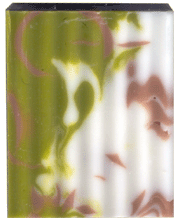 El Don Soap Bar
El Don Soap Bar
Ingredients: Commercial crafting melt and pour soap base, cosmetic grade colorants, soap fragrance (Leather, Masculine Musk, Juicy Lime, Green Tea (Soap Crafters), Sandalwood, Frankincense, Myrhh).
Canola Harvest cooking spray used for mold release. 70% rubbing alchohol sprayed on for soap layer adhesion and bubble reduction.
This batch was made mostly from leftovers that already had some fragrance in it. I added some extra Frankincense and Sandalwood during Step 3. All of the color mixes I used in this soap were opaque.
- Mix up a batch of light brown soap, about the color of hot chocolate. Pour into a container and let it harden.
- Cut curls from the light brown with a melon baller or your curl-cutting tool of choice. Fill a suitable container or loaf mold with the curls, spraying periodically with rubbing alcohol or Bubble Buster. I used a large yogurt container for this project.
- Mix one batch of pearly white soap and one batch of pearly green soap in separate glass measuring cups. You'll be pouring these two colors simultaneously, so try to melt them at the same time and get them to the same state of liquidity at the same time. It doesn't have to be exact, just close. Add fragrance now.
- Let the two melted batches start to form a skin on top.
- Remove the skin, then pour both batches at the same time, one on each side of the mold. Don't move the cups much while you pour if you want a two-tone effect like my sample.
- Gently tap the sides to dislodge any bubbles and allow them to float to the top. Use the alcohol or Bubble Buster to break bubbles on the surface.
- Let the mold sit undisturbed until the soap is hard. Such a large chunk of soap might take several hours to harden completely. To be safe wait until it has cooled off completely and then wait some more. It will be worth the wait!
- Pop the loaf out of the mold, slice, and enjoy!
Citrus Mint Potpourri
Ingredients: mandarin orange peel, home grown peppermint leaves, home grown lemon basil leaves, Orange Spice Fragrance Oil, scented salt dough strips (flour, salt, cornmeal, cosmetic grade powdered coloring, Lemongrass essential oil, Peppermint essential oil).
Here are the steps to make it:
- Wash and peel a bunch of mandarin oranges. Cut the peels into strips, and let them dry on a cookie sheet until they are crisp. Eat the oranges (yum!).
- Put the peels into a large container such as a cooking pot or big salad bowl. Add a few drops of Orange Spice fragrance oil. Stir it up and let it sit for a few days with a cover on it. Stir it every once in a while.
- Add a handful or two of dried whole Peppermint leaves and dried whole Lemon Basil leaves. I grew these, but you can probably buy them from an herb supplier. These are really easy to grow yourself if you want to. I can say from experience that in the St. Louis area climate you will soon have mass quantities of them with no effort at all!
- Mix up a batch of salt dough, and if you care about making it look pretty add some yellow coloring. Add a few drops of Peppermint and Lemongrass essential oils.
- Roll out the dough into a sheet, cut it into strips, and let the strips dry. Add them to your mix when done.
- Put the Potpourri into the bags or containers of your choice. For this batch I used drawstring muslin bags which I first dyed with tea, then rubber stamped with fabric ink.
Sunny Apple Potpourri
Ingredients: Home-grown Korean Hyssop (Agastache rugosa), Chamomile flowers*, home-grown Pennyroyal**, Orris Root Powder, Life of the Party Apple Fragrance, and Star Anise essential oil.
*NOTE: The supplier from where I ordered the flowers says on their web site that it can be used for herbal tea, but after I ordered it I found out that was not the case, it's of a grade for external use only. So I will be using it in bath teas, potpourri, and things like that.
**NOTE: Before using Pennyroyal for anything (especially do not use internally), please read up on cautions associated with it's use. Here is an example: Pennyroyal.
Laundry Soap
Save up small soap bar scraps and motel soaps and make laundry soap out of them!
Ingredients:
Bar soap scraps
Water
Borax
Optional: Fragrance oils or essential oils
Instructions:
Chop soap bar scraps into 1" pieces and put into a large plastic bucket. Add enough water to cover and make it easy to blend. Blend with a stick blender until mixture is reasonably smooth, adding more water as needed. Add powdered Borax until the mixture is like a milkshake. If you want to, add fragrance or essential oils.
Carpet Freshener
The Borax in this recipe is not strictly necessary, but it is said to dry up flea eggs so it might be useful to add it.
Ingredients:
2 heaping tsp Borax
8 heaping tsp Baking Soda
20 drops fragrance or essential oils of your choice
Instructions:
Mix all ingredients in bowl and break up any lumps. Pour into a container with a shaker top - I use a sugar dispenser. Sprinkle on carpet, let sit for several hours and vacuum up.
Bath Tea
*Ingredients: Calendula flowers, Chamomile flowers, Rose Hips, Red Clover, Eucalyptus leaves.
*NOTE: The supplier from where I ordered the flowers and herbs says on their web site that it can be used for herbal tea, but after I ordered it I found out that was not the case, it's of a grade for external use only. So I will be using it in bath teas, potpourri, and things like that. All of the ingredients I used are from Wholesale Supplies Plus.
Instructions: A few minutes before you draw your bath, put a handful of bath tea into a pot, cover with two or three cups of water, and bring the mixture to a boil. Turn off heat. Strain out the herbs and add the liquid to your bath right before you get in.
Lotion for Acne-Prone Skin
This mixture alone did not cure my acne (after years of trying different things something I have to take internally did the job), but it seems to help skin to heal quickly.
Ingredients:
Witch Hazel
Dried Chamomille flowers
Dried Rose Hips
Dried Calendula flowers
Dried Lavender flowers
Dried Eucalyptus leaves
Instructions: Put dried herbs into a large glass jar and pour Witch Hazel over all. Shake well, put on lid and store in refrigerator. You can start using it right away, but the longer it steeps the stronger it will get. When you're ready to use some, strain a portion into a small glass jar and apply to skin with cotton pad.
I try to get everything I can out of the strained out herbs - I make a batch of bath tea with them, then I put them on the garden for compost!
Facial Mask for Acne Prone Skin
Ingredients:
Make a selection of one or more from this list of dried herbs: Bay, Calendula, Chamomille, Eucalyptus, Lavender, Lemon Balm, Lemongrass, Marjoram, Mint, Rosemary, Sage, Thyme, Wintergreen, Yarrow, Yucca root.
Fuller's Earth Clay
Moroccan Rhassoul Clay
Aloe juice
Witch Hazel water
Instructions:
Put a selection of dried herbs from the list above into a spice grinder and grind into a powder. Store this powder in a labeled glass jar in a dark place. To one cup of Fuller's Earth clay, add 1 tsp of herb mixture and 1 tsp of Moroccan Rhassoul Clay. Store this mixture in a labeled glass jar also. When ready to use, wet down a quantity of clay mixture with Witch Hazel water, fresh Aloe juice or a combination of those, and spread on face. Leave on until dry then rinse off.
Body Spray
Make to order with your favorite fragrance oil or blend. If you have problem skin, you can customize with helpful essential oils or add a blend that repels insects for outdoor fun. DO NOT USE NEAR OPEN FLAME.
Ingredients:
1 oz vodka
1 oz water
2 ml fragrance oil or essential oils of your choice
Instructions: Pour ingredients in a glass jar and shake well. You can store the mixture in the glass jar until ready to use. Pour into a container with a spray cap to dispense.
Variation: I have to be careful about excessive use of cedarwood oil in my home because I have a pet bird, but before I had the bird, I would make a cedarwood oil spray and apply it to my dust mop when getting rid of spiderwebs in corners. I also sprayed it on house plants and wiped it off with a cloth or soft fluffy paint brush to clean the leaves. It's one of my favorite fragrances and it repels insects too.
Perfume
Ingredients:
1 part fragrance oils or essential oils
6 parts carrier oil (Jojoba, Evening Primrose, Grapeseed, etc.)
Instructions: Mix together and pour into a small glass bottle.
Dusting Powder
Orris root powder is useful as a fragrance fixative, but it has a couple of drawbacks. Some people are allergic to it, and it feels a bit grittier than the starch. If either of those qualities are of concern to you, leave out the Orris Root Powder.
Ingredients:
1 part Orris Root Powder
3 parts Arrowroot Starch or Corn Starch
Fragrance or essential oils
Instructions:
Mix ingredients well in a bowl and add fragrance or essential oils a few drops at a time until the fragrance smells right. Break up any lumps with a fork. Store in a dry place.
Variation: Some people add powdered dried herbs to their dusting powder. I tried that with Calendula petals and found the mixture to be a bit gritty for my taste, but try it if you're interested and see if it works for you.
Herbal Liquid Soap
I grow herbs and when I dry them and harvest the leaves for use in cooking and crafts, I have a lot of stems left over. They are too tough to use in food and not attractive enough to use in potpourri, but are deliciously fragrant so I try to find a use for them before they go on the compost pile. For this recipe, I boiled the stems of lemon basil and peppermint to make a tea, then used the resulting liquid to make liquid soap from concentrate. You know a batch is successful when you keep opening the bottle to smell it and you keep feeling your skin because it's so soft - this is one of those batches!
Ingredients:
Herb stems
Essential oils and fragrance oils of your choice
Polysorbate 20 (optional)
Germaben II (optional)
Humectant (optional)
Aloe juice or powder (optional)
Goats milk powder (optional)
Liquid soap concentrate
Container with pump top
Instructions:
Put herb stems into a large cooking pot, cover with water, and bring to a boil. Let liquid cool. Get a container that is large enough to mix liquid with a stick blender and fill it about half full of the liquid, after straining out the herbs. If you want to use Polysorbate 20, Germaben II or other preservative, Humectant, Aloe or Goats Milk powder, add those now in amounts recommended by the manufacturer. Add your chosen essential oils or fragrance oils and mix well with the stick blender. I used a blend of Black Pepper EO, Fresh Grass FO, Lemon EO and Basil EO for mine - it smelled heavenly with the herbal fragrances already in the liquid. If you want to use the soap for a special purpose such as skin care or killing germs, select the appropriate essential oils to add to your mix.
Start adding the liquid soap concentrate bit by bit, blending as you go, until the thickness is right for dispensing from a pump-top container. The liquid will look opaque until the bubbles settle out, then it will clear up to a beautiful tea color. Pour into a clear container to dispense.
Other suggestions for using dried herb stems:
- Make bath tea
- Break up and put in a cloth bag to scent your drawers, closets, or laundry when it's tumbling in the dryer
- Soak in vinegar to make flavored vinegar
- Grind up in a spice grinder and mix with dough for fragrance pastilles
- Add to the fire while grilling food
- Put in a Potpourri crock pot to scent the house
Sunscreen
This recipe is originally from the blog Frugally Sustainable, altered. It makes a solid product than can be dispensed from a deodorant tube. I don't make any guarantees about what the actual SPF factor of this blend is. Please read the original recipe and the comments first then use your own judgement and use with caution. I can say that I tried it on my arms in late April and was outside in full sun for five hours from Noon to 5 pm. I only applied it once and had no pinkness on my arms at the end of the day. I can't guarantee you'll get the same results (I'm dark-haired and while my skin is pale in the winter, I tan well after turning pink first if I get too much sun) but I was very pleased and will continue to use it on myself. The Black Cumin Seed Oil was included because it seems very nutritious for the skin, but I don't believe it has any sunblocking properties, so feel free to substitute another oil if you don't have any or increase the amount of Wheat Germ Oil. Due to the Beeswax content if you have acne-prone skin I would not recommend using this formula on your face since it's likely to block your pores. I chose the essential oils Lavender and Peppermint for this recipe because they may have some sunblocking properties and also are insect-repelling. If you decide to use other essential oils, be sure not to use any that are phototoxic such as the citrus oils.
Ingredients:
1/2 oz Raspberry Seed Oil
1/4 oz Wheat Germ Oil
1/4 oz Black Cumin Seed Oil
1 oz Beeswax
�
1/2 oz Shea Butter
1/2 oz
1 TBSP Cocoa Butter
3/8 oz Zinc Oxide
3/8 oz Titanium Dioxide
15 drops Lavender Essential Oil
15 drops Peppermint Essential Oil
Deodorant Tubes
Instructions:
Set up a double boiler by placing a glass measuring cup in a pan of water. Place on medium heat. Melt Raspberry Seed Oil, Wheat Germ Oil, Black Cumin Seed Oil, Beeswax, Shea Butter and Cocoa Butter. Wear a dust mask for the next step when handling powdered oxides. When completely melted, remove from heat and stir in Zinc Oxide, Titanium Dioxide, and essential oils. Pour into deodorant tubes and let harden.
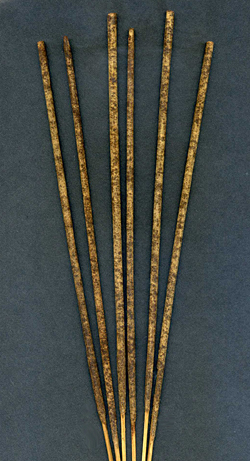 Insect Repelling Incense Sticks
Insect Repelling Incense Sticks
My brother likes to grill so I made him some incense sticks to keep bugs away while he's enjoying time in the backyard. They turned out to smell so good that I've been burning a few in my studio just to enjoy the fragrance while I work - I felt more relaxed and creative for some reason! (My studio is not near my pet birds' cage - don't burn incense or candles near birds!)
Ingredients: Unscented incense sticks, DPG (Dipropylene Glycol), Citronella essential oil, Litsea Cubeba essential oil, Camphor essential oil, insect repelling essential oil blend (contains eucalyptus, lavender, palmarosa, citronella, rose geranium and rosemary), Neem oil, Rosemary Oleoresin Extract (ROE), Lime Citronella soap fragrance.
Instructions: I took out a shot glass and added one eyedropper each of all the ingredients except the DPG and Lime Citronella fragrance. I filled the rest of the shotglass to the top with the fragrance. I emptied the shotglass contents into a glass measuring cup then added three more shotglasses full of DPG and mixed well. I placed the incense sticks in a glass baking dish and poured the mixture over the sticks then covered with foil and let soak for 24 hours. To dry I poked the sticks into a chunk of scrap styrafoam and let sit out. They burned ok the next day but I wasn't sure they were totally dry so I let them dry a few more days.
The sticks make a good room air freshener until burned so I'm going to store mine upright in a vase. I had some fragrance mixture left over so I stored and labeled that for future use. I'm so pleased with this first attempt at incense making that I'm going to order some natural ingredients for making incense cones from scratch and phase out the synthetic ingredients once they are used up. The smoke smell mixed with the fragrances is so much better than the fragrances by themselves!
4. Favorite Fragrance Blends
Blends such as these can be used to scent personal fragrance products, bath salts, pastilles or sachets, candles, room spray, linen spray, carpet freshener, bath fizzes, soap, shampoo, lotion, and more. Try some of these or make up your own blends.
|
1 part Clary Sage EO*
1 part Ylang Ylang EO
1 part Bergamot EO
1 part Sandalwood FO*
2 parts Patchouli EO
1 part Vanilla Lavender FO
1 part Sandalwood FO
2 parts Spiced Bay FO
2 parts Patchouli EO
1 part Sandalwood FO
1 part Baby Powder FO
1 part Pine Forest FO
1 part Allspice FO
1 part Patchouli FO
1 part Spiced Bay FO
8 parts Woodsmoke FO
16 parts Hazelnut FO
2 parts Patchouli FO
2 parts Cedar FO
1 part Sweetgrass FO
1 part Desert Sage FO
2 parts Black Pepper EO
1 part Fresh Grass FO
1 part Basil EO
1 part Lemon EO
|
|
4 parts Green Tea FO
3 parts Masculine Musk FO
3 parts Leather FO
1 part Lime FO
5 parts Woodsmoke FO
3 parts Hazelnut FO
2 parts Fresh Grass FO
1 part Oakmoss FO
1 part Mandarin Dreams FO
7 parts Coconut FO
4 parts Lime FO
1 part Cucumber Melon FO
1 part Sandalwood FO
1 part Lemongrass EO
1 part Vanilla FO
1 part Lavender FO
1 part Sandalwood FO
1 part Orange FO
1 part Pine Forest FO
1 part Cedar Chest FO
1 part Lavender FO
2 parts Cedarwood EO
1 part Lavender EO
1 part Patchouli EO
|
|
2 parts Cedarwood EO
2 parts Sandalwood FO
1 part Palmarosa EO
4 parts Cedarwood EO
2 parts Rosemary EO
1 part Vetivert EO
8 parts Cedarwood EO
4 parts Sandalwood FO
2 parts Vanilla FO
1 part Masculine Musk FO
1 part Patchouli FO
1 part Cedarwood EO
1 part Northwoods FO
1 part Lemongrass FO
1 part Green Tea FO
8 parts Sweetgrass FO
1 part Woodsmoke FO
1 part Fresh Grass FO
1 part Sandalwood FO
2 parts Lilac FO
1 part Sandalwood FO
|
|
1 part Vetivert EO
1 part Cypress EO
2 parts Clary Sage EO
2 parts Cedarwood EO
1 part Hyacinth FO
1 part Fresh Grass FO
1 part Pine Forest FO
2 parts Cedarwood EO
4 parts Cypress EO
4 parts Northwoods FO
20 parts Fir Needle EO
1 part Sandalwood FO
1 part Ocean FO
1 part Spruce FO
1 part Northwooods FO
3 parts Magnolia FO
1 part Woodsmoke FO
1 part Frankincense FO
1 part Mandarin Dreams FO
|
|
*EO - essential oil
*FO - fragrance oil
|
How to Create Your Own Fragrance Blends
I've found that creating a fragrance blend is in some ways similar to creating a piece of visual artwork. First I familiarize myself with the materials, then I build up a collection of "tools" that I like (in this case Fragrance Oils and Essential Oils are the tools), then I play with the materials and wait for inspiration to strike - after inspiration hits, then I get a little more organized with my activity.
When it's time for a new blend, first I get out my bottles and start sniffing. Certain ones will inspire me more on certain days - just like you're in the mood for certain colors or flavors on different days or different times of the year, you'll be in the mood for different fragrances at different times. I pick one that will be the focus and then pick out two to five others that I think will complement it.
Now it's time to start thinking about what proportions to use of each fragrance. If I want one to dominate, I'll use more of that one. If some smell very dominant coming out of the bottle and I don't want it to overwhelm the others, I'll use less of it. If it smells weak coming out of the bottle, I'll use more of it. At this point I jot down what I think the proportions will be - 2 parts this, 5 parts that, etc.
Now it's time to test this mix to see how it performs. You can mix a small batch and put it in a glass bottle with some carrier oil or vodka, and test it out. Another way to test is to dispense a small amount of your blend from an eyedropper onto a coffee filter, then put the filter in a glass jar let sit for awhile, then sniff. If you like it, mix a bigger batch. If you think it needs work, make adjustments and test again until you are satisfied. Always make sure not to put fragrance or essential oils on your skin without diluting them first.
If you have any leftovers from your test batches, save them. Try blending some of these test batches together later - you might discover a great new combination!
Professional perfumers think in terms of Base Notes, Middle Notes and Top Notes. You can make a chart of what fragrances you have available and what category they fit into and try to make sure to include some of each in your blend. Sometimes I do that, at other times I just let my nose be the guide.
If you want to learn to blend fragrances "properly", there is a lot to learn, I've barely scratched the surface of what there is to know. Perfumery would certainly be a worthy hobby for those with the inclination to go further, and a rather glamorous one at that. Society figures sometimes have custom blends made just for them. You don't have to be an expert to make a blend that pleases you and helps you to present yourself as uniquely you.
5. Useful Essential Oils, Herbs and Botanical Products
I am not a doctor, herbalist, scientist, botanist, chemist or anything like that. My university degree is in Fine Art. I think if you have a medical condition you should see a doctor. That said, I do like to experiment with essential oils and herbs to make life more pleasant and make me feel better when I have a cosmetic issue or want to accomplish some specific aim around the house such as repelling insects or making the closets smell good. Some "official" medications, cleaning and cosmetic products are based on plant products, so their use as home remedies is not an unreasonable or unproductive pursuit - it can be fascinating and very educational to study the useful properties of plants. Reading about folk remedies of the past is also very interesting from a historical standpoint. Some folk remedies I wouldn't think of trying, they seem more destructive than helpful, while others seem to be quite good. It's very romantic and interesting to try to do things "the old way" but I think it's also important to keep in mind that sometimes the old way was the only way so they did the best they could with what they had and we might have something better now. Since useful plants and human beings have a long history together, the names of the plants, whether common or scientific contain a lot of interesting lore in themselves.
I initially acquired fragrance oils and essential oils and dried herbs for the purpose of making soap, and figured once I have them in stock why not see to what other uses they can be put? Some household cleaning products and many cosmetic products that I used to buy I have replaced with my own concoctions. I have listed uses gleaned from many different sources to which herbs and essential oils have traditionally been put in case you are interested in doing your own experimenting.
Safety Precautions
If you make products to sell, please make yourself familiar with labeling laws so that you don't get in trouble or harm people. Some essential oils and herbs can be dangerous, and some that are safe if used correctly can be dangerous in excessive amounts or to people who have allergies or certain medical conditions. You must take extra care to avoid accidental poisonings if there are pets or children in the house. They are more sensitive than adult humans, and even a small quantity of some essential oils or herbs can be fatal to a pet or a child (and sometimes adults too). You should also be wary if you are pregnant or lactating.
Some preparations can get contaminated with mold or bacteria and become a safety hazard that way, so please do research to make yourself aware of what products need a preservative and what kinds of preservatives are safe and in what amounts. You will find a lot of varying opinions on that and it's an issue you probably will have to do some reading on and make your own informed decision.
Essential oils can be very potent and should not be used directly on the skin unless mixed with something as a carrier, such as soap or lotion or oil, and they are not for internal use. Plants that are safe to use as food can be deadly in essential oil form. Too give you an idea of the potency, undiluted essential oils and fragrance oils can eat plastic (not to mention kill people in some cases), so store your oils and blends in glass containers and label them carefully to avoid mixups. They can also be flammable (that goes for fragrance oils too). The manufacturer should provide you with information about what the flash point is. If you don't have an allergy to an essential oil initially, it is possible to develop one as a result of overexposure.
I have not included any herbs or essential oils on this list that I know to be dangerous if used in a responsible way and I have used them all myself in various ways with no apparent ill effects, but I would recommend that you do your own research before attempting to use them, especially if you're allergy-prone. I have no allergies that I know of so I'm not a good test subject for allergens. You might be much more sensitive to the following plant products than I am. Do not rely on the information in my list alone, I have made an effort to make it accurate but it may not be complete and the information is only as good as my sources. You will notice that many of the herbs on this list are culinary. Do not assume that just because an herb is consumable that it is 100% safe in all uses and forms - Peppermint essential oil can burn if used in excess, too much Sage can cause liver damage and too much Nutmeg can cause hallucinations, to cite a few examples. When you read different sources on herbs, you will find varying opinions on safety and efficacy. To be safe, I recommend following the most conservative opinion. Unfortunately asking a doctor for advice may not help - my doctor is a traditional Western medicine kind of doctor and he's aware of what herbal products I use, but he's not able to guide me much because he mainly knows about "traditional" drugs. I'm not down on Western medicine at all - my interest in herbs is not based on mistrust of the medical profession or commercial drugs and preparations, though of course they are not infallible either. I've found that in some cases, I can make something at home for cosmetic use or cleaning that works just as well and either smells better, works better, or is in some way superior to the commercial product. And at other times the commercial product IS better and necessary.
You must be careful about your sources of herbs and essential oils. I am not knowlegeable enough to feel comfortable with wild harvesting herbs for my own use and I don't want to deplete populations of wild plants, so I grow a lot of my own. Picking the wrong plant has proved fatal for some people. If I grew it, I know exactly what it is and under what conditions it was grown and harvested. I know it's free of pesticides and not mixed with anything else. You also want to avoid using plants from along the roadside margins1. For essential oils and herbs you can't grow yourself, try to get them from a reputable supplier. That is very subjective and difficult to quantify. I consider it a good sign if the supplier has been in business awhile and has a good reputation, tells you the scientific name and country of origin of each product, provides safety information about the products they sell, and when providing guidance on safety or efficacy, is on the conservative side.
Another thing to keep in mind about herbs is that the amount of active ingredient in the plant can vary depending on where it was grown, how it was grown, when it was harvested, what part of the plant you use and possibly other factors that I'm not aware of. There is a good reason to try to synthesize drugs in a lab - it's not necessarily just an excuse for pharmaceutical companies to make money off of us. An incorrect dose can fail to help or kill outright. Some people believe that nature, God, or whatever you want to call it created plants for our use and there are other constituents in the plant besides the active ingredient that drug companies isolate or synthesize that we need for healing. I don't know if that's true or not, but we are often told that vitamins we get from food are more easily used by the body than vitamins we get from a pill, so it doesn't sound crazy to think that a whole plant might have benefits. After all we know some herbs do contain vitamins and minerals. My advice is not to self-diagnose, not to attempt to treat yourself with herbs for medical conditions, and be conservative, be fully informed, and leave plenty of room for error if you do want to experiment with cosmetics and fragance-oriented crafts.
I've had hours and hours of fun and learned a great deal from growing my own herbs, reading about them and using them and essential oils in different ways. I enjoy learning about the use of plants throughout human history and feeling a connection with our ancestors by learning about ancient knowledge collected over time. I certainly don't know enough to be an expert - just a hobbyist. I must stress again that if you're not careful, plants and plant products can also be injurious or deadly if you mess with the wrong ones or use too much! I'll list my sources for information at the end of this list, I urge you to do additional reading of sources you trust if the useful properties of plants are of interest to you.
I've included information about how some of these plants perform in my garden. I live in a humid continental type climate and the zone is listed as 5 or 6 depending on the source. More information about some plants I grow in my garden is here, and photos of my garden are here.
Aloe - Aloe spp.
I don't know exactly what species of Aloe I have around the house, but the gel from the leaves is wonderful for burns. I also use it as part of the liquid when I do a face mask treatment. Scientific tests show that is has anesthetic, antibacterial, and tissue restorative properties10. All Aloe plants have more or less the same properties. The gel promotes the removal of dead skin and the stimulates the growth of living cells12. Fresh gel is best but if you don't have the plant on hand you can purchase it in powdered and liquid form. For external use only. It's easy to grow as a house plant. More information on Aloe from Drug Digest.
Amyris - Amyris balsamifera
Anise - Pimpinella Anisum
This plant is in the same family as Queen Anne's Lace, parsely, carrots, lovage and fennel. It's a well-known culinary herb and the crushed seeds are nice in tea as well. It's been traditionally used as a remedy for digestive issues10. Anise is also used for it's fragrance. Fishermen like the oil as a fish attractant. This plant is likely to attract Black Swallowtail Butterfly caterpillars to your garden. Essential oil cautions: Avoid when pregnant, not for children, possible skin irritant, sensitizing4.
Food Recipes with Anise Spice
Basil (Sweet) - Ocimum Basilicum
Most of us know this herb as culinary, and it's also grown for it's fragrance, ornamental qualities, and for use in cosmetics10. It is also thought to be helpful with a variety of disorders involving the stomach6. It also has antibacterial properties12. There are many species and varieties of Basil available other than Ocimum Basilicum and some are better for some uses than others. Other than Sweet Basil, I've grown Lemon Basil (might be Ocimum × citriodorum) and Red Rubin Basil. In my experience they will hybridize if you grow them near each other. In my opinion, Sweet Basil has the best flavor, Lemon Basil is good in cooking and potpourri and tea, and Red Rubin Basil is best as a fragrance and ornamental plant. Lemon Basil is the easiest of these to grow for me, it reseeds readily - once you have it, you'll probably always have it unless you try to get rid of it, but I doubt you'll want to becasue it smells so good! It attracts bees - I've seen praying mantises taking advantage by hanging out just below the flowers to nab unsuspecting bees that landed. Essential oil cautions: Not for small children, avoid sensitive skin, possible carcinogenic, hepatoxic4. More information on Basil from Pag-Hat's Garden and From Nature With Love.
Food Recipes with Basil Herb
Bay - Laurus nobilis
The essential oil may cause dermatitis in some persons10. It is said to be an astrigent, to aid digestion, to reduce flatulence, to stimulate appetite, and to have narcotic properties, so use it sparingly6. Essential oil cautions: Avoid when pregnant, possible skin irritant, potentially sensitizing4.
Food Recipes with Bay Leaves
Bergamot - Citrus bergamia
Essential oil cautions: Phototoxic, possible carcinogenic, possible skin irritant4.
More information on Bergamot essential oil from Soapcrafters.
Black Pepper - Piper nigrum
Essential oil cautions: Possible skin irritant, high levels may damage kidneys4. More information on Black Pepper essential oil from Wholesale Supplies Plus.
Calendula - Calendula officinalis
This plant is sometimes called "Pot Marigold" but it is not the same as the Marigolds from the Tagetes family. The flower is edible and can also be used to make fabric dye10. Calendula tea is rich in phosphorus and vitamin C. It is astrigent and reduces perspiration6. It is said to remove warts and makes a good hair rinse for blondes and brunettes8. It has antiseptic properties and helps heal skin irrations and injuries12. It is also recommended for external use as a painkiller7. In Native American tradition, it is used for inflammations, sunburn, and skin disorders1. The seeds survive through the winter in my climate. More information on Calendula from Drug Digest.
Camphor - Cinnamomum camphora
Essential oil cautions - potential toxic reaction. Possible convulsant, neurotoxic. Avoid when pregnant4. For external use only. Sometimes used topically for itching, toenail fungus and pain relief. Do not apply to broken skin. Use in a low concentration, not more than 11%. Not for use on children15.
Cardamom - Elettaria Cardamomum
The seeds are a culinary and aromatic herb and are said to help with digestion10. The seeds smell so good that I once soaked them in a carrier oil then added bergamot to make a perfume. The results where not overwhelming, but nice. If I could figure out how to get the fragrance more intense, I'd try that combination again. Essential oil cautions: Possible skin irritant4.
Food Recipes with Cardomom Spice
Catnip - Nepeta Cataria
You might want to grow this one to make your own cat toys. I also drink a tea made from the leaves and flowers when I think I need some help sleeping. Science has found evidence that the sedative effect may be real, and it's regarded as safe by many though herbalist Michael Moore warns that it might increase menstrual flow10. Catnip improves circulation and helps reduce fatigue from muscle exhaustion12. A small percentage of people react to catnip as a stimulant rather than a relaxant6. Like other members of the mint family it's easy to grow and attracts beneficial insects to the garden. More information on Catnip from Drug Digest.
Cedarwood - Juniperus Virginiana
The essential oil is one of my all time favorites. I have had to curb its use in cleaning and scenting the house in areas where my pet bird spends his time because birds' respiratory systems are very sensitive. When I hand-wash clothes, I like to put a couple drops in the rinse water. It's often an ingredient in personal fragrance products I make for myself. Essential oil cautions: Avoid when pregnant, possible skin irritant, phototoxicity, sensitizing4. More information on Cedarwood essential oil from From Nature With Love.
Chamomile - Chamaemelum nobile, Matricaria recutita
Chamaemelum nobile, Roman Chamomile, is a perennial plant and Matricaria recutita, German Chamomile is an annual. They look similar, but the Roman version has a stronger fragrance10. I have tried to grow both and it is not easy in my area, I may not have enough sun or maybe it's too damp here. I have never gotten enough to grow to harvest it, so I buy it also, but I have gotten the annual kind to come back from seed a couple of times. The flowers are fragrant, smelling like apples, and very nice in potpourri. Chamomile tea is very popular for relaxation, but if you have known sensitivities to ragweed, chrysanthemums, or other members of the Compositae family you should be cautious about possible allergic reactions10. Chamomile tea also makes a good rinse for blonde hair8. More information on Chamomile from Drug Digest.
Cinnamon - Cinnamonum Zeylanicum
We all know Cinnamon as a spice, it's also a great fragrance. I like to add Cinnamon sticks to tea, spiced coffee, and to my potpourri crock pot. Japanese researches have found that Cinnamon contains a substance that kills fungi, bacteria and other microorganisms10. It is not recommended for pregnant women12. Essential oil cautions: Skin, mucus membrane irritant, sensitizing. Avoid when pregnant and with ulcers. Not for children. Use highly diluted4. More information about Cinnamon Leaf essential oil from
Wholesale Supplies Plus.
Food Recipes with Cinnamon Spice
Citronella - Cymbopogon nardus Rendle
We mostly know Citronella oil as an insect repellent. In cosmetic use, it's used in perfumery, hair care, soap, and it cleanses the sebaceous glands8. Essential oil cautions: Potentially sensitizing4.More information on Citronella essential oil from Soapcrafters.
Clary Sage - Salvia Sclarea
Leaves of Clary Sage can be used in food and tea. Clary oil is used commercially as a fragrance10. It makes a good fragrance fixative8. Essential oil cautions: Avoid when pregnant, with endometriosis and cancer. Potentially sensitizing4. More information on Clary Sage essential oil from Wholesale Supplies Plus.
Cloves - Syzygium aromaticum
The familiar spice has anesthetic and germicidal properties10. Clove oil can also be used against foot fungus12.
Food Recipes with Cloves Spice
Coffee - Coffea arabica Coffee is considered a fairly safe stimulant in small amounts and in excessive amounts can have the following undesireable side effects - nervousness, insomnia, rapid and irregular heartbeat, elevated blood sugar, elevated cholesterol, excess stomach acid and heartburn. James Duke, Ph.D., a botanist with the U.S. Department of Agriculture rates 2 cups of coffee a day as a 2 on a scale of 0 to 3 - "not real safe, not real poisonous"10. I gave up caffeinated coffee a few years ago because my blood pressure was up a bit and I wanted to see if getting rid of caffeine would make it come down - it did. I still enjoy the aroma and taste in decaffeinated beverages, and the fragrance can be nice in scented crafts as well.
Coriander/Cilantro - Coriandrum sativum
The spice coriander is the dried seeds of this plant, and the foliage is the herb Cilantro. No one would ever say the foliage is aromatic but it is delicious in some recipes. The ripe seeds have a nice smell and flavor, and are said to aid digestion6. Cilantro does not like to be transplanted in the garden so I just let it reseed itself year after year. It seems to be one of those plants that does better with benign neglect rather than with being overly fussy with care.
Food Recipes with Coriander/Cilantro Herb and Spice
Cypress - Cupressus sempervirens
Essential oil cautions: Avoid when pregnant, with high blood pressure and with cancer4.
Dill - Anethum graveolens
Eucalyptus - Eucalyptus spp.
Eucalyptus oil is used as a germicide, for respiratory ailments, and as an expectorant for coughs. The oil also repels insects10. It may be used externally as a deodorant. Eucalyptus oil should not be used in large quantities over long periods of time since it is difficult to eliminate from the kidneys12. Essential oil cautions: Avoid with high blood pressure and epilepsy. Not for small children4. More information on Eucalyptus from Drug Digest and Soapcrafters.
Evening Primrose Oil - Oenothera Biennis
I like this as a carrier oil for perfumes. Evening Primroses are really interesting plants. My Mom and Dad had a 5-6 foot tall variety in their garden, which came from a wildflower mix, turned out to be a biennial and did not reseed. It was fun to go out to their garden right before sunset and watch the flowers spring open for night pollinators. I have a 1 1/2 foot tall variety in my garden that is a perennial. There are so many plants in this family that I'm not sure what kind mine is. Avoid Evening Primrose Oil if you have epilepsy1. More information on Evening Primrose from Drug Digest and Wholesale Supplies Plus.
Fennel - Foeniculum vulgare
This plant is likely to attract Black Swallowtail Butterfly caterpillars to your garden. All parts of the plant are considered safe for human consumption but the oil of the seed can be irritating or dangerous to those with allergies10. The seeds and roots are thought to be helpful for a variety of digestive issues6. The plant is a good source of Vitamin A12. Essential oil cautions: Avoid in pregnancy, epilepsy. Potentially sensitizing4.
Food Recipes with Fennel Herb and Spice
Fir Needle - Abies Sibirica
More information about Fir Needle from Wholesale Supplies Plus.
Ginger - Zingiber officinale
Traditionally used for stomach problems, digestion problems and nausea. I've found that drinking tea made from the fresh root or eating crystalized ginger will sometimes help me with a headache. Ginger promotes circulation10. Tastes good too! Essential oil cautions: Potential skin irritant, sensitizing, phototoxic4. More information on Ginger from Drug Digest.
Food Recipes with Ginger Spice
Geranium - See Rose Geranium
Grapefruit - Citrus Paradisii
Whenever I eat a Grapefruit I like to put the peels in a potpourri crock pot with a covering of water and enjoy the fragrance. Essential oil cautions: Potential skin irritant, sensitizing, possibly mildly phototoxic4. More information on Grapefruit essential oil from Wholesale Supplies Plus.
Green Tea - Thea sinensis
Contains caffeine. Technically, only tea made from this plant should be called "tea", and all others are really "herbal infusions", but in this guide I'm using "tea" to mean any herbal infusion, which is the way most people use the word.
Gurjum Basalm - Dipterocarpus turbinatus
Used as a fragrance fixative.
Hops - Humulus lupulus
Hops are used in beer brewing for aroma, bitterness, and as a preservative. Hops also have a calming effect, which can be too much for some people. There is speculation that the terms "Hopping Mad", "Hopped Up" and "Hophead" come from bad experiences with this herb13. I have brewed myself some hop tea and found the taste terrible and won't be doing it again unless it's for bath tea, but if you are interested in trying it, drink it in moderation, avoid prolonged use, and avoid if you suffer from depression 6. Hops are often recommended for use in sleep pillows. Making the pillow from quilted fabric is supposed to quell the rustling sound from the hop flowers. Hops also have antiseptic properties and used externally as a hot poultice are said to reduce inflammation10. The oil in hop flowers goes rancid quickly so I store my hops in the freezer to slow down deterioration. More information on Hops from Drug Digest and Pag-Hat's Garden.
Horehound - Marrubium vulgare
Horehound tastes terrible unless it's sweetened heavily, but I can vouch for its effectiveness as a remedy for sore throats and coughs. I made myself some Horehound candy once that worked as well if not better than any cough drop I have ever used - and tasted better too. It's easy to grow and stays green a long time in the fall, so it's always welcome in my garden. Like other members of the mint family it attracts beneficial insects. It can be used as a wash for skin dermatitis conditions to promote healing12. Large does can cause irregular heartbeat, and be careful not to confuse Marribum vulgare with Ballota nigra which may be toxic in large quantities10. More information on Horehound from Drug Digest.
Hyssop - Hyssopus officinalis
I used to be able to grow this, but the last couple of years have been wetter and colder than normal and maybe that's why I haven't had much luck lately. I keep Hyssop tea on hand to drink when I have a cold. The taste is mild and inoffensive and if there is any medicinal effect it seems subtle to me. Hyssop is mentioned in the Bible, but so many fragrant plants have Hyssop in the common name that it's hard to say whether Hyssopus officinalis is the plant that was referred to. The leaves are used by some to cure infection and promote wound healing, and Hyssop has also been used to dispel head lice8. It also is believed to have anti-viral properties and has been used to reduce perspiration12. Essential oil cautions: Avoid with high blood pressure, epilepsy, pregnancy. Possibly neurotoxic. Not for children4. More information on Hyssop from Pag-Hat's Garden.
Juniper - Juniperus communis
Should not be used internally as a medicine, only in small amounts as food. Some use it externally on swellings, bruises, and sores 10. It has antiseptic qualities12. Juniper berries can be dried and strung like beads - if you have traveled in the American Southwest you may have seen necklaces of Juniper berries for sale. Avoid during pregnancy12. Essential oil cautions: Avoid extensive use on delicate skin, with kidney or bladder disease, when pregnant. Potentially sensitizing4. More information on Juniper from Drug Digest.
Food Recipes with Juniper Berries
Kelp (Brown Seaweed)
Kelp granules and kelp powder can be added to skin care products, but if you do be aware that the finished product will really smell like the sea and might be a little fishy. Adding a nice fragrance oil can help mask the odor a bit if you don't like it. As a food, it's very nutritious and it sounds like it has lots of possibilities as a nutraceutical. More information on Kelp from Drug Digest.
Korean Hyssop - Agastache Rugosa This is one of many plants that has "Hyssop" in the common name but is not related to Hyssopus officinalis. Like other members of the mint family it's easy to grow - one of the easiest plants of all time if you ask me. As a tea herb and culinary herb it has a mild taste. The whole plant is very fragrant and it's joy to have in the garden for that reason and also because of the wildlife it attracts - for example hummingbirds, hummingbird moths, bees and butterflies. I like to use it as a potpourri base because the flowers and leaves dry well and I'm able to grow it in huge quantities. More information on Korean Hyssop from Pag-Hat's Garden.
Lavender - Lavandula angustifolia
The flowers are very fragrant and the stems and leaves, although a little different, are fragrant also. The dried flower buds are excellent in food and in tea, and Lavender's use in cosmetic products and fragrances is legendary. The name lavender comes from Latin verb "to wash". It is said to be good for repelling mosquitoes and for treating oily skin10. It is also said to helpful with insomnia, halitosis, flatulence and a few other things6. Some people keep the flowers on hand to make tea for coughs7. Lavender will grow in my climate but it's not easy to get it big enough to harvest the quantities I want to use. Luckily there is a Lavender farm in my area where you can go pick the fresh blossoms for a fee. More information on Lavender from Pag-Hat's Garden.
Food Recipes with Lavender Flowers
Lemon - Citrus Medica limonum
Whenever I eat a Lemon I like to put the peels in a potpourri crock pot witha covering of water and enjoy the fragrance. Dried lemon powder makes a very pleasant-smelling exfoliant in a bar of soap. Some use it to stop the bleeding of shaving nicks8 because it has blood-clotting ability, so give it a try in shaving soap. Essential oil cautions: Potential skin irritant, sensitizing, phototoxic4. More information on Lemon essential oil from From Nature With Love.
Lemongrass - Cybopogon flexuosus
Essential oil cautions: Avoid when pregnant, not for children, possible skin irritant, sensitizing4.
Lemon/Lime Balm - Melissa officinalis
I grow both a lemon and lime variety. The dried leaves are great in potpourri, though you might want to boost the scent with fragrance or essential oils, and are very mild and inoffensive in flavor if added to teas and food. If there is any medicinal effect, it's not enough to be noticeable by me. It may have mild sedative, antiviral and antiseptic properties10. Like other members of the mint family it's easy to grow and attracts beneficial insects to the garden. In my climate it's one of the easiest plants to grow that I've ever seen. The name Melissa, the Greek word for bees, reflects the use of the herb as an attractant for bee swarms. If you raise bees, you might want to try growing it and rubbing it in your hives as the ancients used to do. Essential oil cautions: Possible skin irritant, avoid when pregnant4. More information on Lemon Balm from Drug Digest and Pag-Hat's Garden.
Food Recipes with Lemon/Lime Balm
Lime - Citrus Aurantifolia
Whenever I eat a Lime I like to put the peels in a potpourri crock pot witha covering of water and enjoy the fragrance.
More information on Lime essential oil from Wholesale Supplies Plus.
Marjoram - Origanum Majorana
Marjoram has mild antioxidant and antifungal properties. It may irritate the uterus if used during menstruation or pregnancy but is otherwise considered safe10. Marjoram is useful in bath teas, potpourris and sachets. The Romans used it in foot baths8. It can be used as an antiseptic for cuts and wounds12. Essential oil cautions: Avoid when pregnant, with athsma, low blood pressure4.
Food Recipes with Marjoram Herb
Litsea Cubeba - Litsea cubeba
Also known as May Chang. Lemony scent, often used to anchor lemon and citrus fragrances. To my nose there is a hint of grass in the fragrance. May help oily and acne-prone skin. Low sensizitation risk 16.
Neem Oil - Azadirachta indica
Considered to be anti-bacterial, anti-viral, anti-fungal, antiseptic and anti-parasitic14. It is often used for repelling insects on people, animals and in the garden. It can also be used to control fungal diseases in plants. It has a strong odor, kind of warm and smoky to my nose. Not what you'd wear as perfume but not bad if masked with other things. The leaf could be dangerous if taken internally especially to children, pregnant or breast feeding mothers or people with certian medical conditions15. The oil is for external use only.
Olive Oil - Oleum olivae
Not only is Olive Oil valuable is a food, it is sometimes used as a skin treatment or carrier oil. More information on Olive Oil from Drug Digest.
Orange - Citrus Sinensis
Orange oil is my go-to remedy for getting label glue off of bottles. I use the oil full strength for this purpose but I wear disposable rubber gloves so I don't get it undiluted on my skin. Whenever I eat an orange I like to put the peels in a potpourri crock pot with a covering of water and enjoy the fragrance. Essential oil cautions: Potentially sensitizing, phototoxic4. More information on Orange essential oil from From Nature With Love.
Orris Root Powder - Iris Xgermanica var. florentina
Has a great fragrance on it's own and it's used as a fragrance fixative also. Many people are allergic to it so be cautious with it. The fragrance is improved when the dried roots are aged for two years10.
Palmarosa - Cymbopogon martini
Smells a bit like roses or geraniums (to my nose a lot closer to geraniums). May help to balance oily and dry skin. Caution: avoid while pregnant and do not use on babies14.
Parsley - Petroselinum crispum
Rich in vitamins A, B, C, and K. Pregnant women should not consume parsley in tea 6. It also contains iron and potassium12. Parsley oil can be toxic in large quantities and irritate the kidneys10. This plant is likely to attract Black Swallowtail Butterfly caterpillars to your garden. Parsley tea has been used cosmetically to try to get rid of freckles7.
Food Recipes with Parsley
Patchouli - Pogostemon patchouli
A really nice fragrance that can also be used to keep insects out of clothing8.
More information on Patchouli essential oil from Sweetcakes.
Peppermint - Mentha piperita
Like other members of the mint family it's easy to grow (almost too easy - it's a very aggressive plant) and attracts beneficial insects to the garden. Peppermint contains Menthol oil. The herb is often used to help with digestive upsets and is safe to use but may be too strong for infants and young children10. I find it helpful for some headaches. Many members of the mint family grow from seed but Peppermint does not, it is a sterile hybrid. It spreads so easily that you will have no trouble getting extra plants if you want them. If you're working in the garden and are bothered by mosquitoes, try rubbing some Peppermint leaves on your skin. It also has antibacterial properties8. Sachets that include Peppermint herb and other members of the mint family have been used to repel insects in the house11. Peppermint contains iron1. Essential oil cautions: Avoid when pregnant or lactating, skin irritant, keep away from infants4. More information on Peppermint from Drug Digest and From Nature With Love.
Food Recipes with Peppermint
Pine - Pinus sylvestris
Essential oil cautions: Potentially sensitizing, avoid with allergenic conditions, cancer4.
Petitgrain - Citrus aurantium
Extracted from the leaves of the bitter orange tree and used in perfumery for a floral and citrusy aroma. For external use only. Essential oil cautions: Non-toxic at low levels, potentially sensitizing4.
Prickly Pear - Opuntia spp.
Fruits and pads are edible if you remove the spines. In Mexican cooking the pads are known as Nopalitos and they taste kind of like green beans. I'm not certain if all species of Opuntia are edible so it might be best to purchase yours from a food market unless you're sure. The pads can also make good poultices for contusions, bruises, and burns9. More information on Prickly Pear from Drug Digest.
Food Recipes with Prickly Pear
Red Clover - Trifolium pratense
The flowers are sometimes used as a cough remedy6. I keep some Red Clover tea bags in my pantry for this purpose, but if it has an effect it's not what I'd call dramatic - Horehound is much better in my opinion. Red Clover has minerals and vitamins in it though, so drinking the tea might have a subtle benefit. It doesn't have much flavor - more like dirt than anything though I wouldn't call it totally unpleasant, so mixing it with more tasty herbs would probably make a better tea. It is grown as a soil improving crop8. The flowers contain the trace element Molybdenum. Red Clover can be used as external wash for boils, sores and acne and it has antibiotic qualities12. More information on Red Clover from Drug Digest and Pag-Hat's Garden.
Rose Geranium - Pelargonium spp.
May have astrigent properties. Grown today mainly for use in the perfume industry 6. The essential oil may cause contact dermatitis in senstitive people. The leaves can be used as a flavoring and as a tea10. There are many varieties of scented geranium in the Perlargonium family and it would probably be a lot of fun to grow several kinds to experiment with the fragrances and flavors. However, in my climate they will not survive the winter and I don't have room to bring in a lot of plants for the season, so I'll restrict myself to one or two. Essential oil cautions: Avoid in early pregnancy4.
Rose Hips - Rosa spp.
Rose hips contain high concentrations of vitamins A, B, E, K, P and C6. They are mildly laxative and diuretic10. More information on Rose Hips from Drug Digest.
Rosemary - Rosmarinus officinalis
This is another one of those Mediterranean herbs that is hard for me to grow, and that's too bad because the fragrance and flavor is one of my favorites. Pregnant women should not consume Rosemary in tea6. Rosemary oil has antibacterial effects and is thought to repel mosquitoes. Large quantities of the oil can irritate the stomach, intestines, and kidneys. Rosemary can be refreshing in the bath by getting the blood flowing under the skin and a tea made from the herb is often recommended as a hair rinse for brunettes10. It also may help with hair loss12. Rosemary contains iron1. Essential oil cautions: Avoid when pregnant and with epilepsy, not for children, possible neurotoxic4. More information on Rosemary from Drug Digest, Pag-Hat's Garden and From Nature With Love.
Food Recipes with Rosemary Herb
Sage - Salvia officinalis
Sage gives off a fragrance that I love. It grows in abundance for me, luckily. In my climate it's almost but not quite an evergreen plant. It's beautfiful in the garden and very useful too. Sage is reputed to repel flies and attract bees. It's medicinal properties include drying up perspiration, use as an astrigent, as an antibacterial agent, and it may have estrogenic properties10. The Romans used Sage in their baths for sore muscles and aching feet8. It helps heal sores and other skin eruptions and relieves the symptoms of insect bites12 . I've found tea made from Sage leaves to be helpful with sore throats and headaches. The tea is also used as a hair rinse or dye for brunettes. Sage tea should be avoided by women who are pregnant or lactating6. Essential oil cautions: Possibly toxic at high levels, should not be used when pregnant or lactating, avoid if epileptic, not for children, possible neurotoxic4. More information on Sage from Drug Digest and Pag-Hat's Garden and Camden Grey.
Food Recipes with Sage Herb
Sandalwood - Santalum album
Sandalwood is expensive to buy as an essential oil so I usually use a synthetic sandalwood fragrance. Any beneficial effects other than odor that Sandalwood may have will not be present in a synthetic substitute. The genuine oil makes a good fragrance fixative and is sometimes used to heal sores8.
Spearmint - Mentha spicata
Does not contain menthol as Peppermint does. Like other members of the mint family it's easy to grow and attracts beneficial insects to the garden. The leaves are chewed as a breath freshener in Native American tradition1. Essential oil cautions: Avoid when pregnant, potential skin and mucus membrane irritant, sensitizing4.
Tea Tree - Melaleuca alternifolia
Tea Tree essential oil is very useful and inexpensive. It's the active ingredient in a medication for aquarium fish called Melafix. Some aquarists, such as myself, make their own version called Melafake (1/4 tsp Tea Tree essential oil to 8 TBSP dechlorinated water). I've successfully used Melafake to treat skin infections in fish and toads with no apparent ill effects to the biological filtration or shrimp and crayfish living in the aquariums (yes I have some weird pets). Some say this treatment may harm labyrinth fishes. Essential oil cautions: Possible skin irritant4. More information on Tea Tree from Drug Digest.
Thyme - Thymus vulgaris
Thyme has been used for ailments such as gastrointestinal complaints, asthma, whooping cough, headaches, inflammations, sores and others, but in large quantities it can be dangerous or even fatal10. I personally would restrict it to culinary use and only use a small amount externally for cosmetic purposes. It has been used for antiseptic purposes6. It's also been used as a deodorant12. I'm very taken with photos I've seen of various varieties of creeping Thyme growing around stepping stones in a garden, but even in a raised bed I have a hard time keeping it alive. I guess I just don't have enough sun. Essential oil cautions: Avoid when pregnant, not for children4. More information on Thyme from Pag-Hat's Garden.
Food Recipes with Thyme Herb
Vanilla - Vanilla planifolia
Vanilla is widely used in food flavoring. The main reason to use Vanilla in soap or bath products is for the fragrance.
Veitvert - Andropogon Muricatus
A wonderful smoky fragrance. It's used to repel insects and as a fixative in perfumes8.
More information on Vetivert essential oil from Wholesale Supplies Plus.
Wintergreen - Gaultheria procumbens
Contains Salicylic acid (methyl salicylate), which is believed to be beneficial for acne because it is an exfoliant, anti-irritant and anti-inflammatory. In my opinion you may want to be cautious about its use if you are not supposed to take aspirin because it is similar but not identical to the active ingredient in aspirin. Oil of Wintergreen is toxic if consumed internally in concentrated form2. The plant is a native wildflower in the US. Native Americans and early European settlers in the US used it as a pain reliever, among other things10. Essential oil cautions: Potentially toxic, skin irritant, sensitizing. Avoid when pregnant, not for children4. More information on Wintergreen essential oil from Wholesale Supplies Plus.
Witch Hazel - Hamamelis virginiana
Do not take internally. Externally Witch Hazel has been put to use for inflammations, bruises, bites, stings, sunburn, after shave lotion among other things8. Witch Hazel water can be purchased at drugstores and makes a nice mild skin lotion. More information on Witch Hazel from Drug Digest.
Yarrow - Achillea Millefolium
This is a pretty and easy to grow plant that will always be welcome in my garden. Butterflies love it! It's native to Europe and naturalized in the US, and there is a similar species in the US that is native. The leaves look like ferns and are almost as pretty as the flowers. There is a patch of it in my Dad's lawn that gets run over by the lawn mower regularly and so never blooms. I suspected it might be Yarrow and moved some to my garden where it produced white flowers - voila! It has a long history of being used to stop bleeding and in the 1950s some scientific evidence was found that it contains a substance that can make blood clot faster. It's considered astrigent and cleansing in cosmetic use10. Yarrow is a mild abortifacient and should be avoided during pregnancy12. Essential oil cautions: Avoid when pregnant, not for children, possible neurotoxic4. More information on Yarrow from Drug Digest.
Ylang Ylang - Canaga odorata genuina
A very nice perfume oil. Essential oil cautions: Possible skin irritant, potentially sensitizing, do not use on inflamed skin, excess may cause headache and nausea4.
Yucca Root - Yucca spp.
Believe it or not, native species of Yucca can be found growing wild in Missouri in the dry glade areas along with other plants and animals more commonly associated with deserts than the Midwest. It's common to find it growing as an ornamental plant in the St. Louis area, presumably because it's almost indestructable not to mention beautiful. My Mom and Dad have grown it in their yard ever since I can remember. Yucca plants can only be pollinated by the Yucca moth. I have no idea what a Yucca moth looks like, but I know they're in our area because I took some seeds from my Mom and Dad's plants and grew them into plants for my garden, proving that they're fertile. Once while helping my Dad move some Yucca plants in his yard, I kept back some of the extra roots for cosmetic experiments since they contain saponin. I sliced the roots into thin pieces, dried them, then ground them into a powder in my spice grinder. I added some to a bar of soap as an exfoliant. It's kind of redundant to add a root containing saponin to soap, but it's fun for a Southwest themed soap bar. Yucca flowers have a wonderful fragrance and are used in perfumery8. In Native American tradition the root is used in facial blemish treatments1. More information on Yucca from Drug Digest.
Sources:
1. Kavasch, E. Barrie and Baar, Karen. American Indian Healing Arts: Herbs, Rituals, and Remedies for Every Season of Life . New York, New York: Bantam Books, 1999. Native American healing involves more than just medicinal plants, so this book includes a sampling of healing rituals and culture in a variety of tribes. . New York, New York: Bantam Books, 1999. Native American healing involves more than just medicinal plants, so this book includes a sampling of healing rituals and culture in a variety of tribes.
2. Art, Henry W. A Garden of Wildflowers . Pownal, Vermont: Storey Communications Inc., 1986. . Pownal, Vermont: Storey Communications Inc., 1986.
3. Drug Digest
4. Hoard, Jeff & Cheryl. Essential Oils. St. Louis, Missouri: Cheryl's Herbs, 1999.
6. Marcin, Marietta Marshall. Herbal Tea Gardens . Pownal, VT: Storey Books, 1993, 1999. . Pownal, VT: Storey Books, 1993, 1999.
7.
Espan, Ceres. Herbal Teas for Health & Healing . Rochester, Vermont: Healing Arts Press, 1984, 1988, 1996. . Rochester, Vermont: Healing Arts Press, 1984, 1988, 1996.
8. Rose, Jeanne. Herbs and Things - Jeanne Rose's Herbal . New York, New York: Workman Publishing Company, 1972. Psychedelic drawings and chapters on hallucinogens and astrology make this book an entertaining cultural relic, but there is some solid information in this book also (along with some recipes included for historical interest that SHOULD NOT be tried). . New York, New York: Workman Publishing Company, 1972. Psychedelic drawings and chapters on hallucinogens and astrology make this book an entertaining cultural relic, but there is some solid information in this book also (along with some recipes included for historical interest that SHOULD NOT be tried).
9. Moore, Michael. Medicinal Plants of the Desert and Canyon West: A Guide to Identifying, Preparing, and Using Traditional Medicinal Plants Found in the Deserts and Canyons of the West and Southwest . Santa Fe, New Mexico: Museum of New Mexico Press, 1989. . Santa Fe, New Mexico: Museum of New Mexico Press, 1989.
10. Kowalchik, Claire and Hylton, William H., Editors. Rodale's Illustrated Encyclopedia of Herbs. Emmaus, Pennsylvania: Rodale Press, 1998. This book is conservative when it comes to safety information and claims of efficacy, so I usually use it as the last word if other sources differ, which is very often! Emmaus, Pennsylvania: Rodale Press, 1998. This book is conservative when it comes to safety information and claims of efficacy, so I usually use it as the last word if other sources differ, which is very often!
11. Irwin, Mamie Susan. Root Digger Nation: Country Medicine from the Civil War and Great Depression. St. Clair, Missouri: Root Diggin' Nation, 2002. I bought this book to learn about folk remedies from my home state of Missouri. Some of the remedies don't sound very appealing (no way am I going to eat things like Kerosene and Turpentine) but others sound like they might have potential. For example there are several references to bacon fat and infections. I personally use bacon fat to get stains out of clothing when even OxyClean won't do it. Could there be some properties in bacon fat that are worth exploring? Things like this intrigue me, though with something serious I would not take chances. However some of the herbs mentioned like Poke, Jimson Weed and Mayapple are dangerous so I'd be cautious about using this book for anything but historical reference. It also contains two Civil War cookbooks and some cold-process soap recipes.
12. Ritchason, Jack. The Little Herb Encyclopedia: The Handbook of Nature's Remedies for a Healthier Life . Pleasant Grove, Utah: Woodland Health Books, 1995. This book is on the liberal side when it comes to safety information and claims of efficacy, but it was a recommended purchase from an employee at a health food store and seems to be well regarded in the field. . Pleasant Grove, Utah: Woodland Health Books, 1995. This book is on the liberal side when it comes to safety information and claims of efficacy, but it was a recommended purchase from an employee at a health food store and seems to be well regarded in the field.
13. Pag-Hat's Garden
14. From Nature With Love web site
15. Web MD
16. Cheryl's Herbs web site
17. Wholesale Supplies Plus web site
Essential Oil Blends I've Tried
|
Acne-Prone Skin Blend
4 parts Bergamot
4 parts Rose Geranium
4 parts Grapefruit
2 parts Juniper
2 parts Patchouli
2 parts Basil
|
|
Antibacterial Blend
1 part Patchouli
1 part Basil
6 parts Lavender
4 parts Sage
4 parts Tea Tree
2 1/2 parts Eucalyptus
|
|
Foot Blend
Pine
Fir
Cedarwood
Patchouli
Juniper
Lavender
Eucalyptus
Tea Tree
|
|
Household Cleaning Blend
1 part Lemon
1 part Lime
1 part Grapefruit
1 part Orange
|
|
Relaxing Blend
2 parts Basil
4 parts Lavender
4 parts Palmarosa
|
|
Insect Repelling Blend
Eucalyptus
Sage
Thyme
Lavender
Peppermint
Rosemary
Citronella
Veitvert
|
|
Sore Muscle Blend
Vetivert
Lemongrass
Rosemary
Juniper
Lavender
Wintergreen
Cypress
|
|
Energy Blend
1 part Rosemary
1 part Rosemary Oleoresin
1 part Basil
1 part Lemongrass
1 part Orange
1 part Peppermint
1 part Grapefruit
1 part Lime
1 part Cypress
1 part Bergamot
1 part Black Pepper
1 part Eucalyptus
1 part Lemon
|
|
Anti-Itch Blend
1 part Tea Tree
1 part Bergamot
1 part Rose Geranium
1 part Lavender
1 part Patchouli
|
|
Relaxing Blend II
1 part Orange
1 part Cedarwood
1 part Bergamot
1 part Patchouli
1 part Basil
1 part Palmarosa
1 part Rosemary
1 part Lemongrass
1 part Lavender
|
|
Cold and Flu Season Blend
Anise
Black Pepper
Camphor
Cypress
Patchouli
Juniper
|
|
|
6. Non-Botanical Ingredients
Baking Soda
Scientific name: Sodium Bicarbonate.
Dead Sea Salt
Description 17.
DPG - Dipropylene Glycol
Liquid solvent produced as a byproduct of the manufacturing of propylene glycol, which is petroleum based. Often used as a carrier base for incense making and reed diffusers.
Epsom Salt
A home remedy for bites and stings 15.
Fullers Earth
A natural clay that reduces oiliness on the skin and is thought to tighten pores17.
Goats Milk Powder
Contains vitamins A, B6, B12 and E. Hydrates dry skin and promotes exfoliation14.
Melt and Pour Soap Base
I use soap bases from a few different manufacturers. Some of the formulas are proprietary so I don't always know exactly what's in them but they are likely to include several of the ingredients on this list: Glycerine, Palm Oil, Coconut Oil, Lauric Acid, Water, Sodium Hydroxide, Sodium Lauryl Sufate, Sorbitol, Triethanolamine, Sodium Chloride, EDTA, Titanium Dioxide, Propylene Glycol, Sodium Stearate, Sodium Laureth Sulfate or Sodium Laurate.
Vitamin E Capsules
The ones I'm using contain dl-Alpha Tocepheryl Acetate, Gelatin (Non-Bovine),Glycerin, Polysorbate 80, Water. Dl-Alpha Tocepheryl Acetate is a synthetic form of Vitamin E. Vitamin E is an antioxidant that helps slow down the processes that damage cells15 and is believed to be beneficial to the skin if applied topically.
7. Packaging Ideas
You will notice in the picture of the Hyacinth Garden bar above on this page that it is wrapped in clear cellophane gift wrap with a gold dot design on it. If I was making a large number of bars as a commerical product, I would do it a different way, but for my small numbers of bars this method works. I fold the gift wrap over the soap bar the way you'd wrap a package, seal the back with tape, then cover the tape with a printed label on the back with the name of the bar and the address of this web page so that people can see what's in it if they want to. In time, it's possible for the gold ink on the wrap to stick to the bar if it's in the wrapper for a long time, so to avoid this I wrap with the printed side out. Sometimes it's hard to tell which is the printed side, as far as I can tell it's the side that's a little less shiny on the gold parts.
I like the wrap with gold dots because the gold gives a little extra touch of elegance that really makes the bar look nice. You could use plain wrap or clear wrap that's printed with a different color if you want. One way I like to present the bars is to wrap them in gold ribbon together with a washcloth in a coordinating color and a wooden soap saver. Tie a little gift tag to the top, curl the ribbon, and it's a package that always draws oohs and ahhs when people see it.
Over the years, just about everybody I know has seen these packages, so I need to think of some more presentation ideas. Last year, I made some small shell guest soaps in swirly greenish brown colors. I bought some ceramic dishes at a housewares store that were in a coordinating color, and put the shell soaps in them on top of some excelsior wood fiber. I put some real seashells in the dish too, and wrapped all in clear cellophane for presentation. This seemed to go over well.
Pillow Boxes
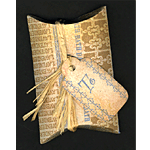 Recently I packaged some lavender scented soap bars in some homemade pillow boxes that I decorated with rubber stamps of my own design. To read my tutorial on how I made the boxes like the one you see on the right, and download free templates, click here - Rubber Stamped Pillow Box.
Recently I packaged some lavender scented soap bars in some homemade pillow boxes that I decorated with rubber stamps of my own design. To read my tutorial on how I made the boxes like the one you see on the right, and download free templates, click here - Rubber Stamped Pillow Box.
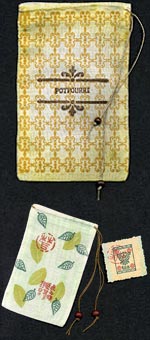 Drawstring Muslin Bags
Drawstring Muslin Bags
These can be used to contain soap bars, potpourri, bath salts, or a variety of other handmade gifts.
You can decorate them with rubber stamps and Crafter's Rubber Stamp Ink, or other stamping inks that are suitable for fabric.
A couple of examples of decorated muslin bags are pictured at the right.
Project Idea: Rubber Stamped Muslin Bag
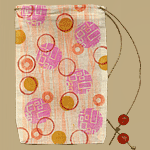 Here is a quick easy project with bold colorful graphics that would make a good bag for a small gift. It's stamped with ColorBox Crafter's ink, which is waterproof after heat setting.
Here is a quick easy project with bold colorful graphics that would make a good bag for a small gift. It's stamped with ColorBox Crafter's ink, which is waterproof after heat setting.
Click here for Rubber Stamped Muslin Bag.
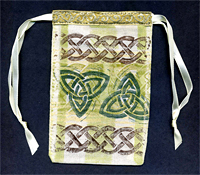 Decorate a Celtic Gift Bag
Decorate a Celtic Gift Bag
Here is an idea for decorating a drawstring muslin bag with Celtic designs. Fill with St. Patrick's Day treats or a gift for someone who would enjoy Celtic designs at any time of year.
Click here for Decorate a Celtic Gift Bag.
8. Resources
Recipes and Information
Recipe Database - natural skin care recipe collection provided by From Nature With Love®.
Soapnuts Library
Make Melt & Pour Soap
Soap Crafters Forum - Recipes and How to Make Stuff
Sweetcakes E-Group - I can't find any melt and pour tutorials on the Sweetcakes web site, but the e-group they sponsor has good information in the archives, plus you can ask questions if you're a member.
Camden-Grey's Handmade Toiletries Group - Another supplier does something similar with their e-group.
Wholesale Supplies Plus Blog - Includes recipes for soap and related bath items.
Swirl and Marble Base - Techniques and Tutorial
Alternative Household Product Recipes
Angela's Handmade
Suppliers
From Nature With Love® - Natural and complementary ingredients used in skin care, hair care, aromatherapy, massage, spa products, herbal preparations, soap making, potpourri and candle making. If you use this link and make an online purchase, you will receive a 5% discount on qualifying items. Items that do not qualify are indicated on the web site. Use the discount code "CHMP7374" at checkout to receive the 5% discount.
Packaging Suppliers
Carolyn's Stamp Store - Embellish your packaging with rubber stamps. Project ideas and free templates too.
Earth Love'n Paper Products – 100% Recycled Gift Wrap and Cards - Earth Love'n Paper Products is committed to creating a more sustainable world though the increased use of recycled paper! Our gift wrap and cards are printed on 100% post-consumer waste, processed chlorine-free premium quality paper.
Finished Soap and Personal Care Products
UncoverMe Naturals - Personal care products that are made with the highest quality natural ingredients allowing you to be healthier and look your best.
Safety Information
Drug Digest Drug and Herb Library
Green Pharmacy - Dr. Jim Duke's Botanical Desk Reference
Dr. Duke's Phytochemical and Ethnobotanical Databases
Purdue University New Crop Resource Online Program
Chery's Herbs Essential Oil Safety Information
National Association for Holistic Aromatherapy Safety Information
Aromatherapy Global Online Research Archives
Herb Research Foundation
American Association of Poison Control Centers - Find a poison control center in your area
Cornell University Plants Poisonous to Livestock
University of Pennsylvania Poisonous Plants Home Page
Canadian Poisonous Plants Information System
CyberCanine Aromatherapy and Pets Information
Bird Toxins and Dangers
FDA Information on Dietary Supplements
FDA Information on Cosmetics
Botanical Medicine Information Resources
Southwest School of Botanical Medicine
Compendium Botanicum
Consumer Safety: An Official Guide to Dietary Supplements
Questions or comments?
Email Carolyn: carolyn_hasenfratz@sbcglobal.net
 Newsletter
Newsletter
Would you like to sign up for my e-newsletter, Carolyn's Creative Connections? It's about how to enhance your life as a crafter, artist, designer, business person, hobbyist or anyone who values creativity. I will definitely discuss crafts and marketing. I might on occasion discuss cooking, travel, gardening, ecology, nature - whatever adds flavor to the creative life. You'll also get notified when I have sales and specials. Exclusively for subscribers - at least one free printable download in every issue!
|
Newsletter
Would you like to sign up for my e-newsletter, Carolyn's Creative Connections? It's about how to enhance your life as a crafter, artist, designer, business person, hobbyist or anyone who values creativity. Exclusively for subscribers - at least one free printable download in every issue!
Events Calendar
Blog Posts by Your Editor
Products from Carolyn's Stamp Store:
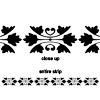
Vintage Floral Border Rubber Stamp
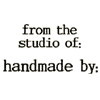
Credit Rubber Stamps
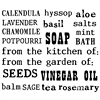
Products of the Kitchen and Garden Rubber Stamps
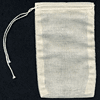
Muslin Drawstring Bag 3 x 5 in
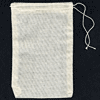
Muslin Drawstring Bag 4 x 6 in
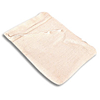
Muslin Drawstring Bag 5 x 7 in

Pennsylvania Dutch Border Rubber Stamp
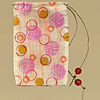
Pink, Orange, Coral and Gold Rubber Stamped Muslin Drawstring Bag
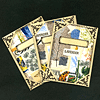
Three Handmade Seed Packets with String Closure – Set 1
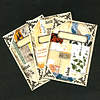
Three Handmade Seed Packets with String Closure – Set 2
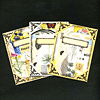
Three Handmade Seed Packets with String Closure – Set 3

Upcycled Tea Box with Sliding Lid

Blue Garden Greetings Plantable Paper – 6 x 9 inch sheet

Cream Garden Greetings Seed Paper – 8.5 x 11 inch sheet

Green Garden Greetings Plantable Paper – 8.5 x 11 inch sheet

Lavender Garden Greetings Seed Paper – 8.5 x 11 inch sheet

Petalled Garden Greetings Seed Paper – 8.5 x 11 inch sheet
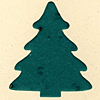
Pine Tree Die Cut

Pink Garden Greetings Plantable Paper – 6 x 9 inch sheet

Yellow Garden Greetings Plantable Paper – 6 x 9 inch sheet
|